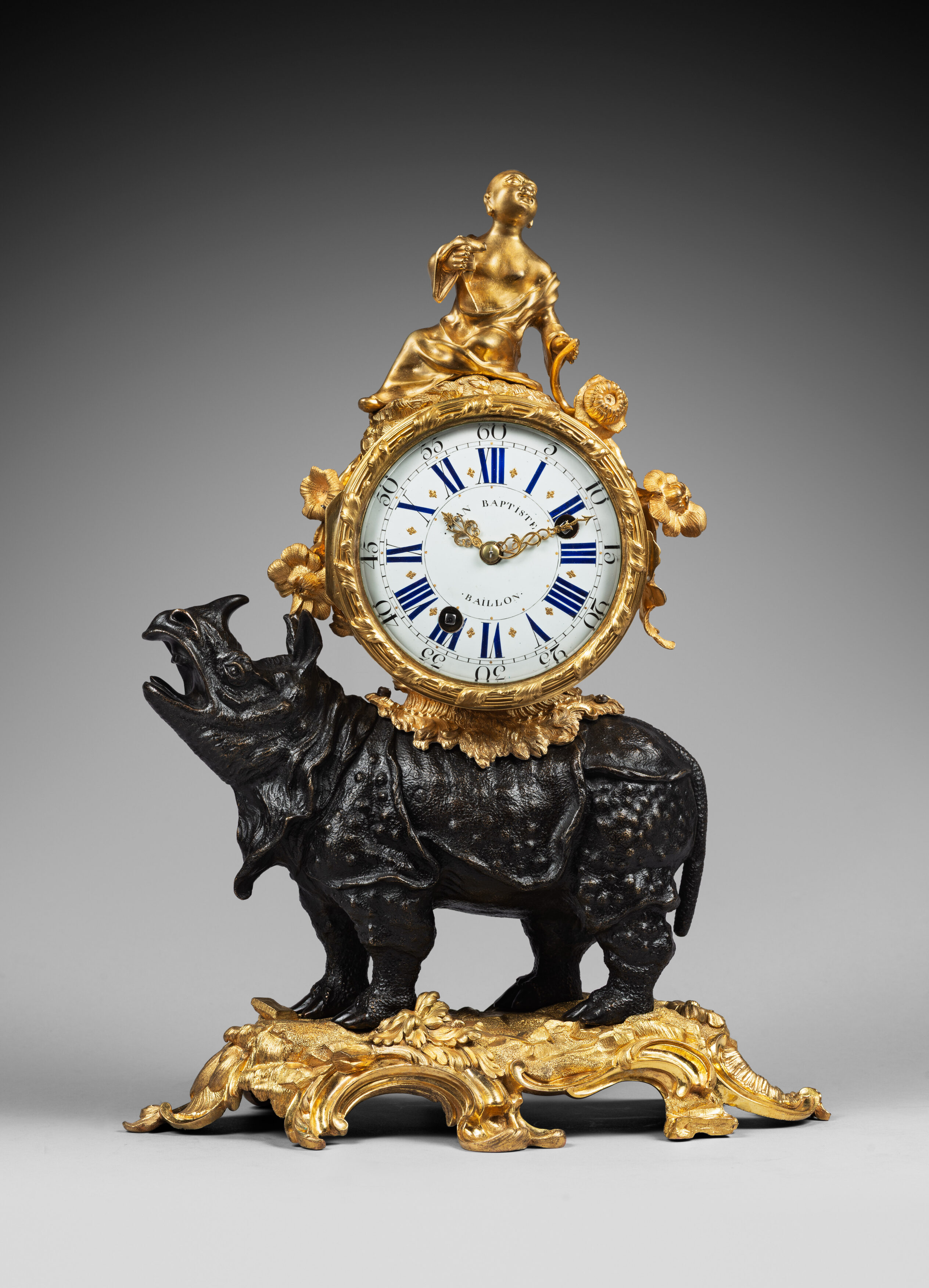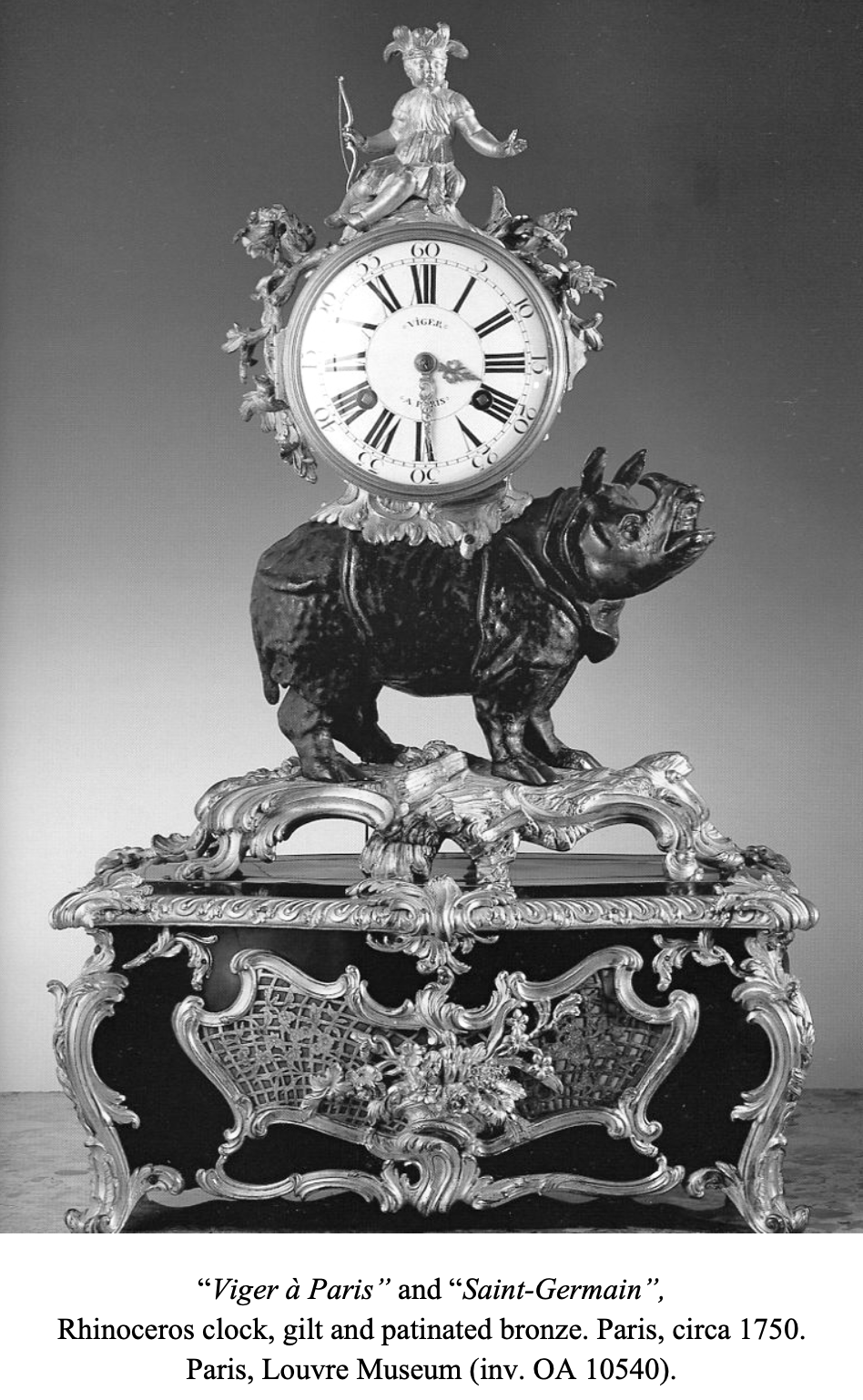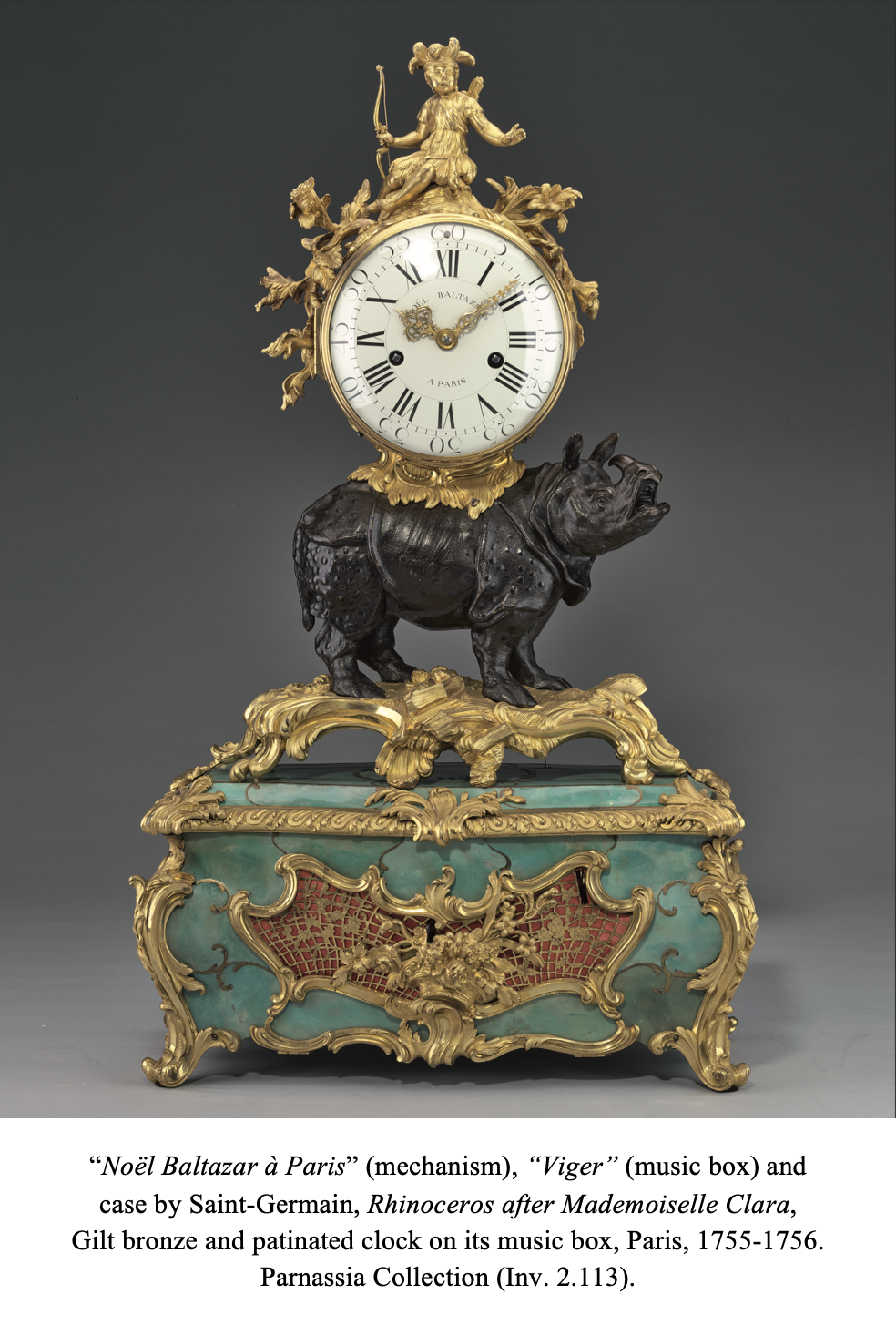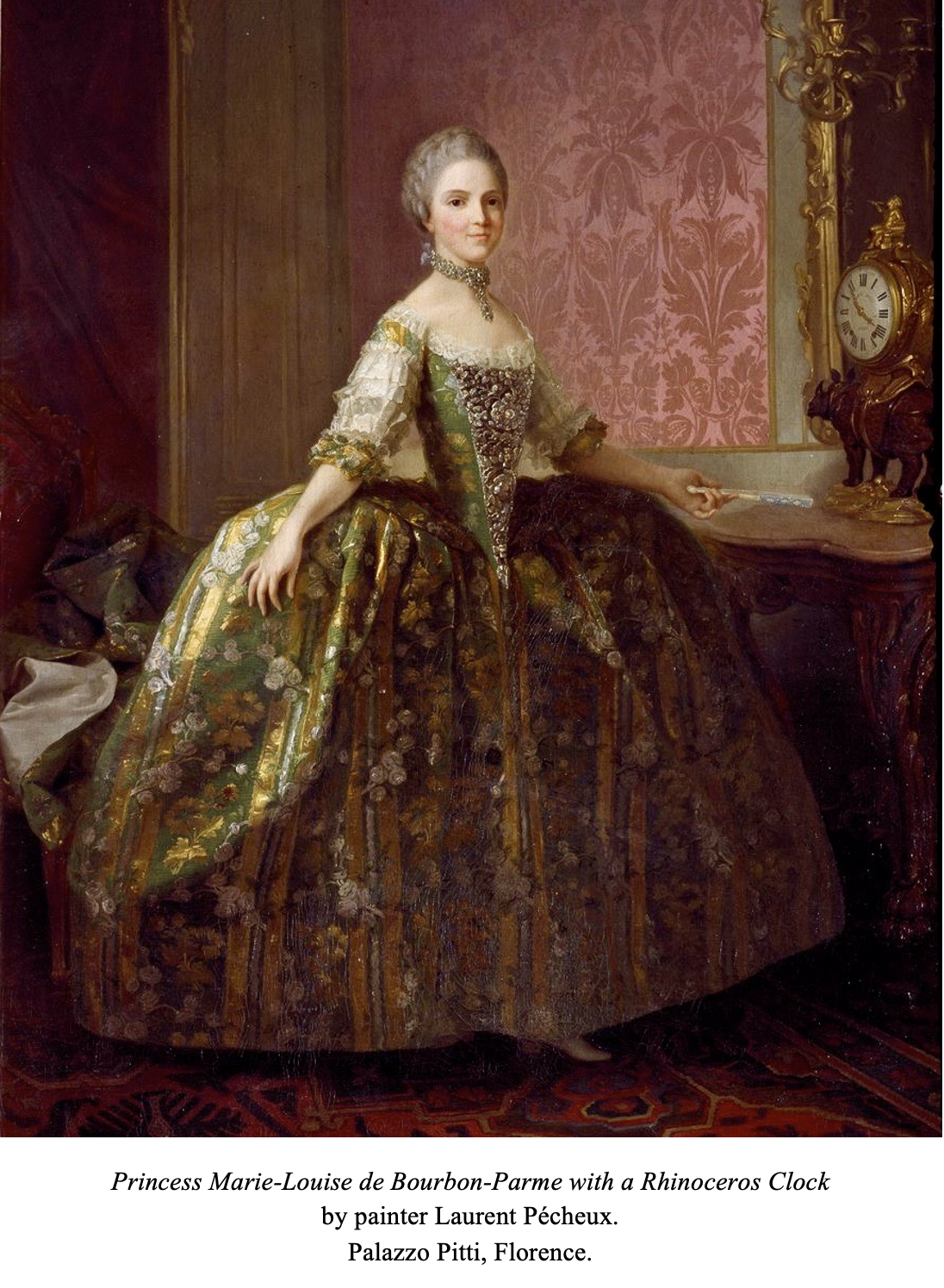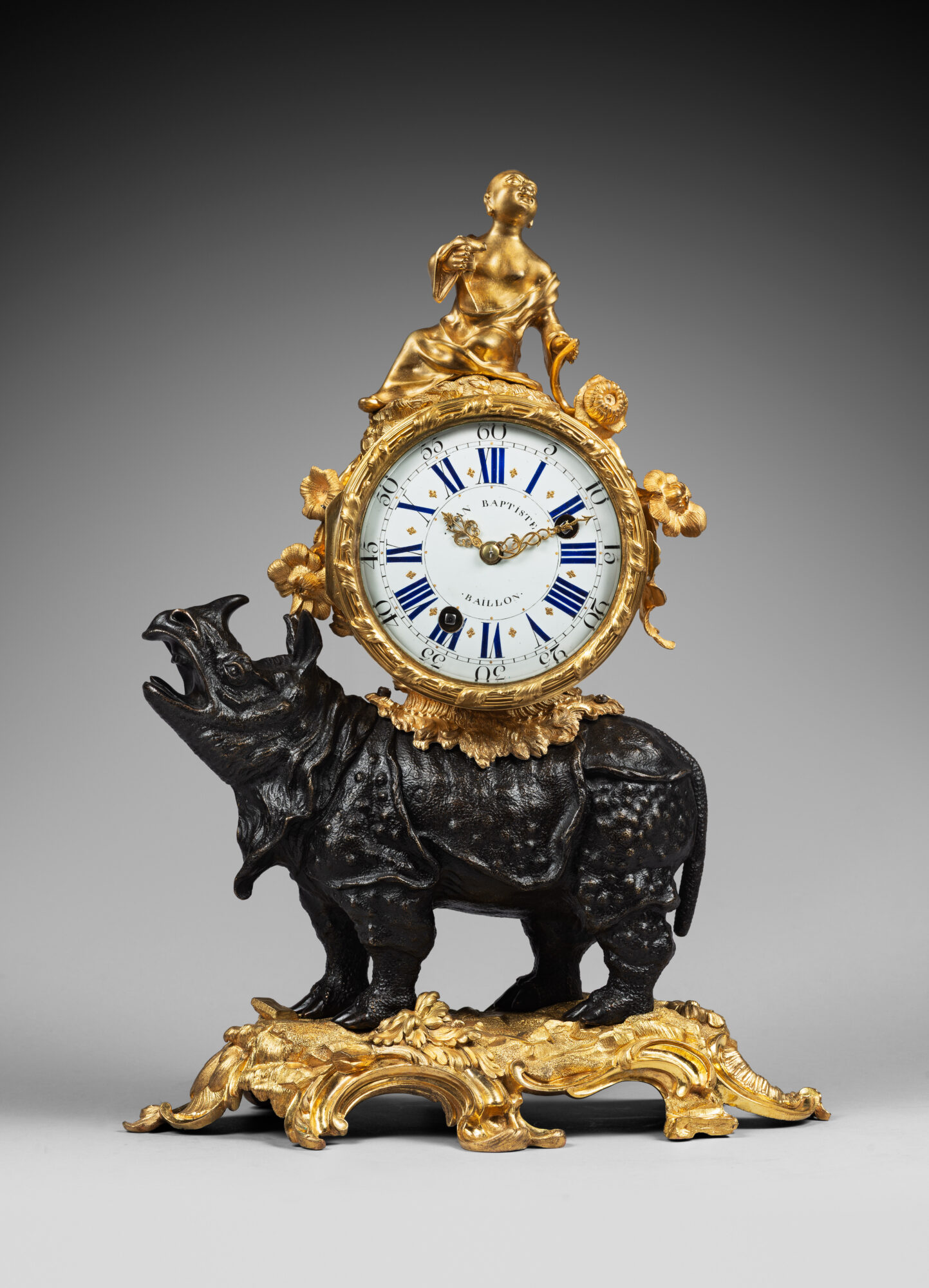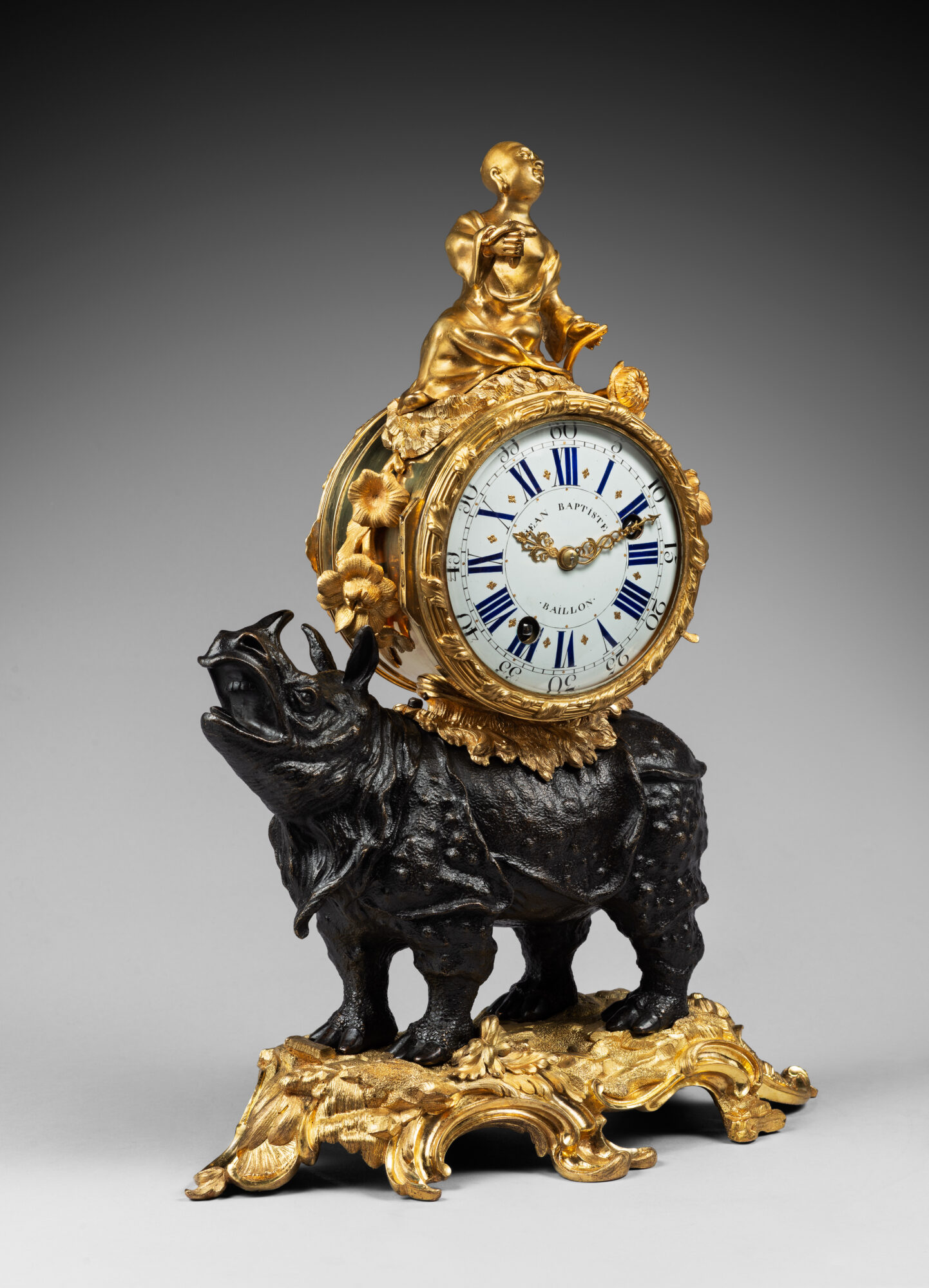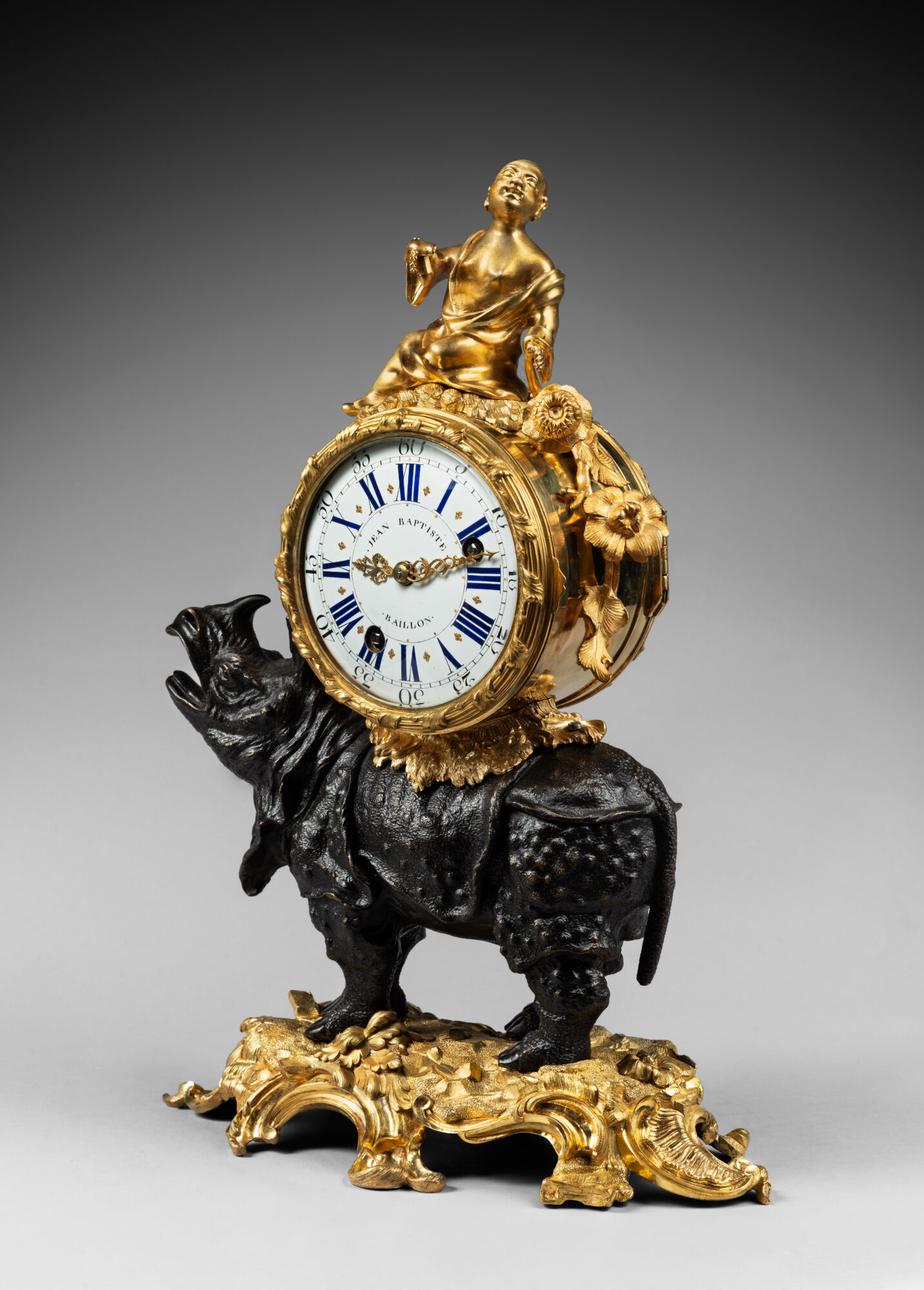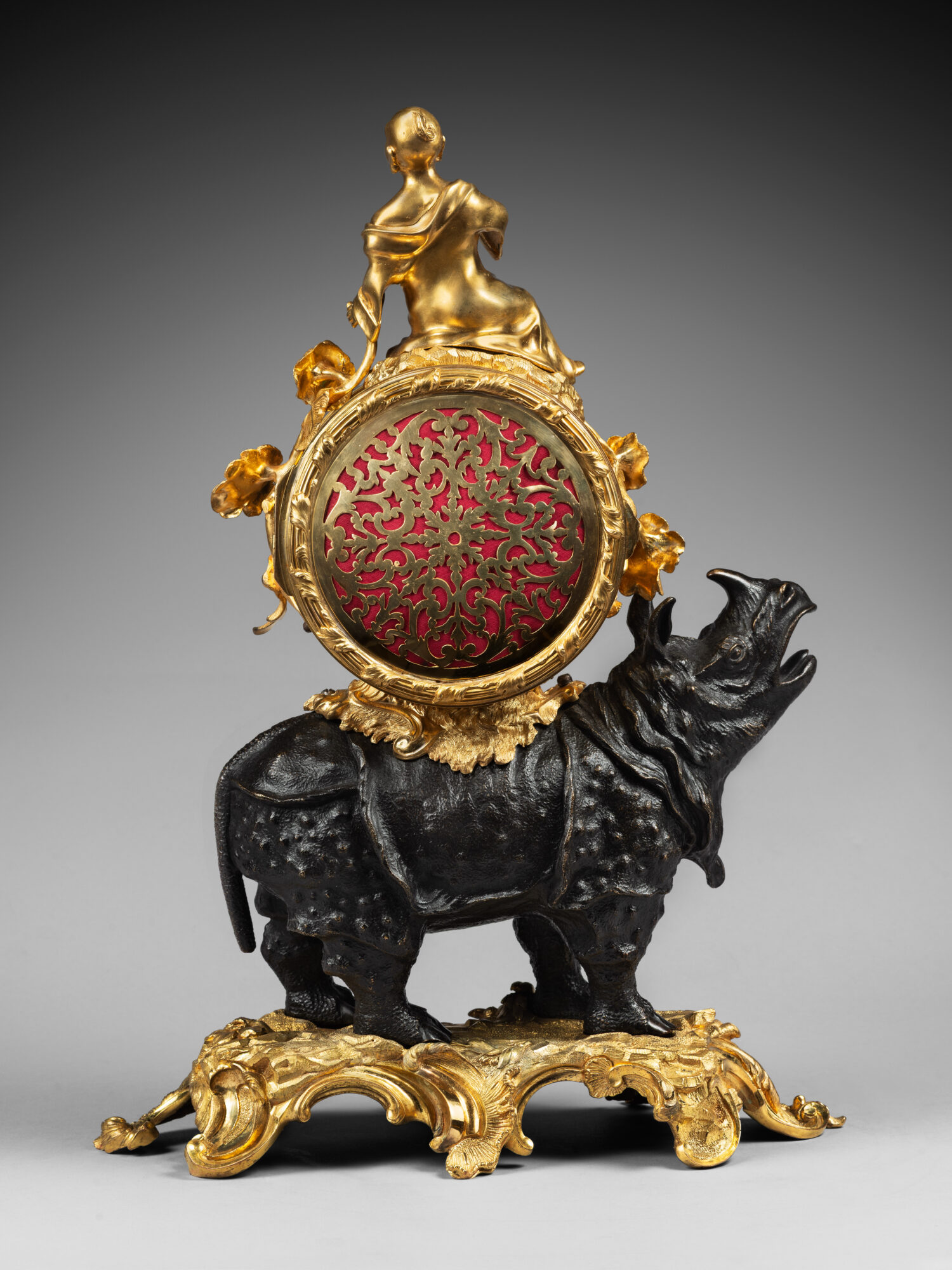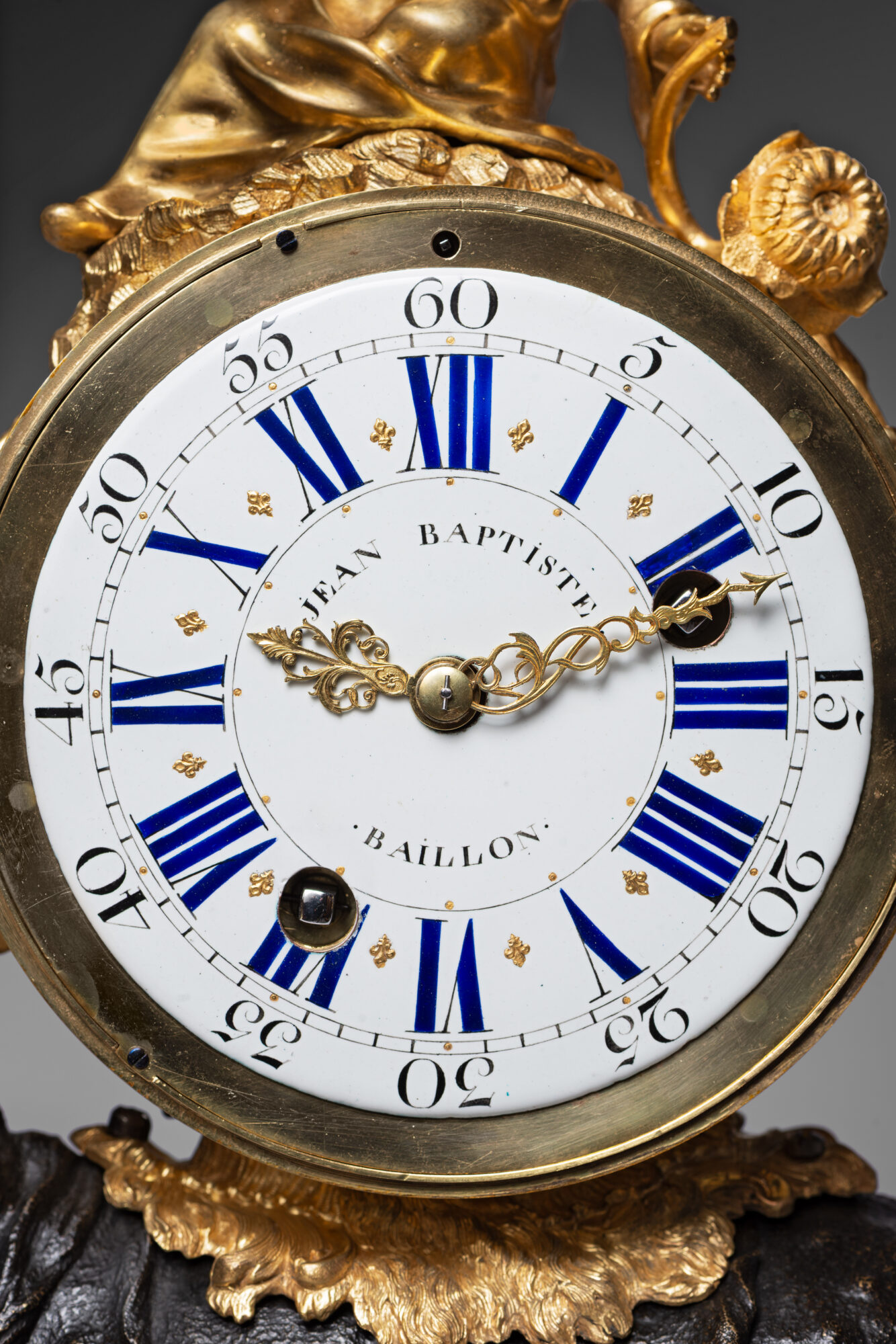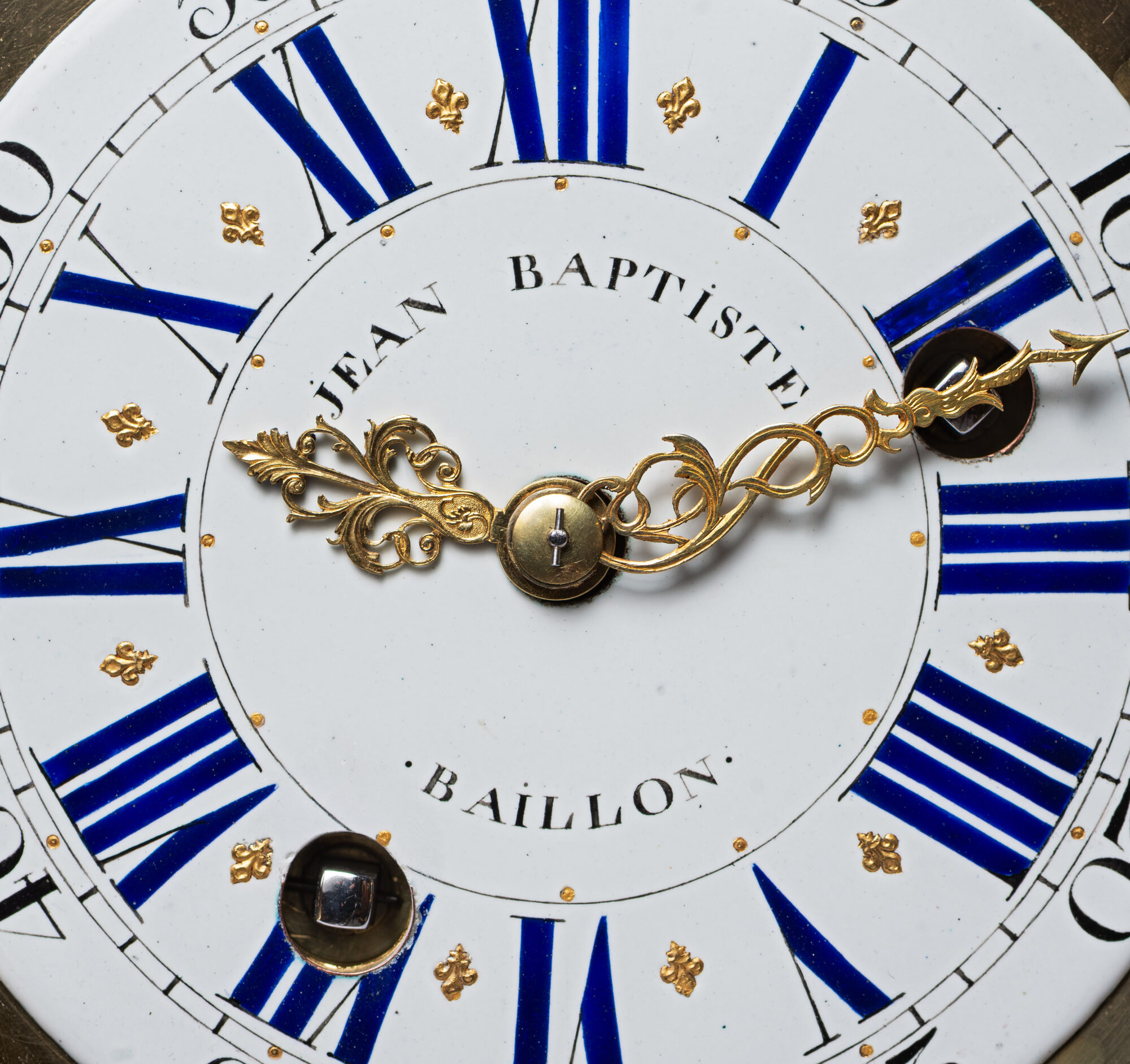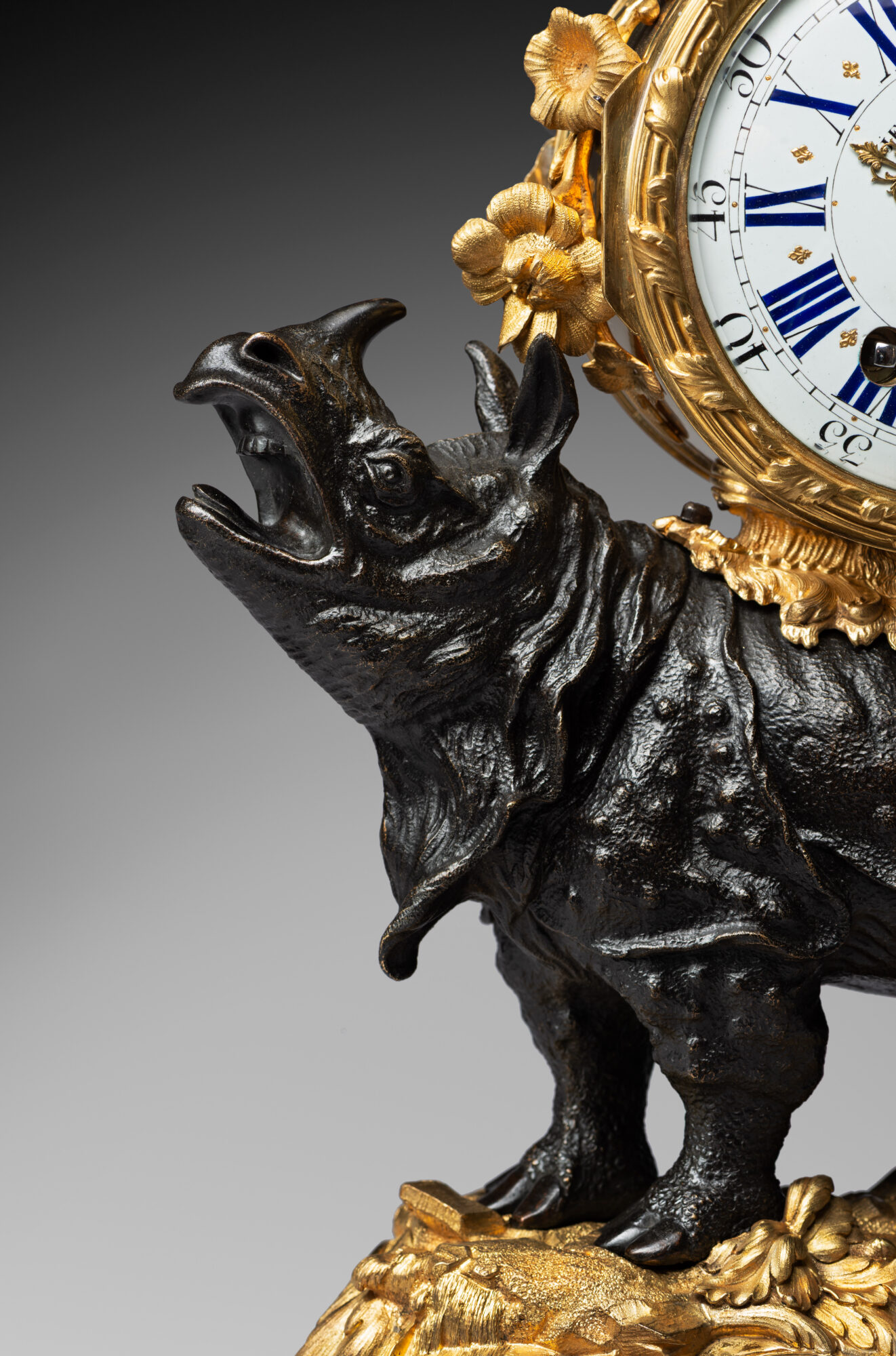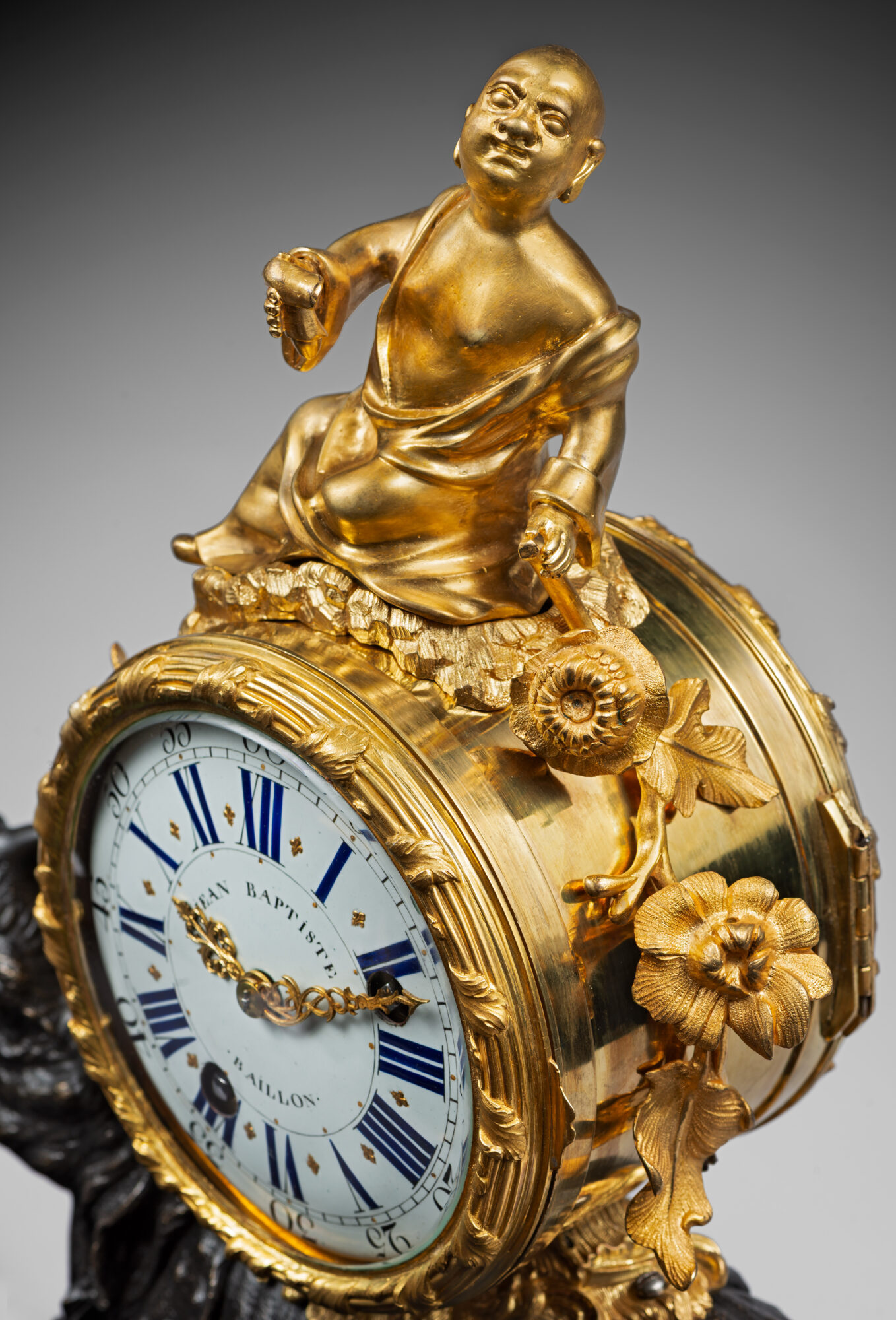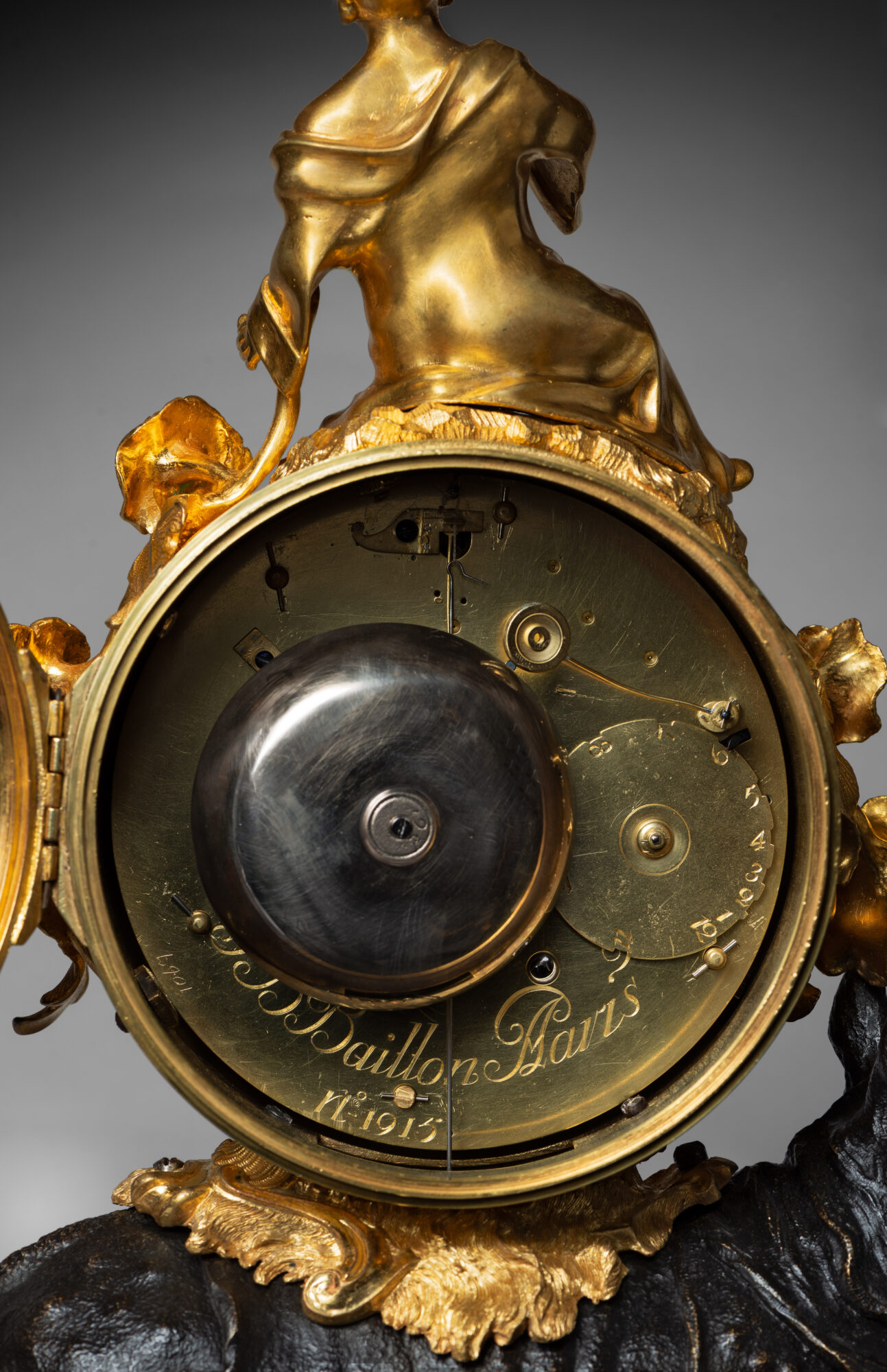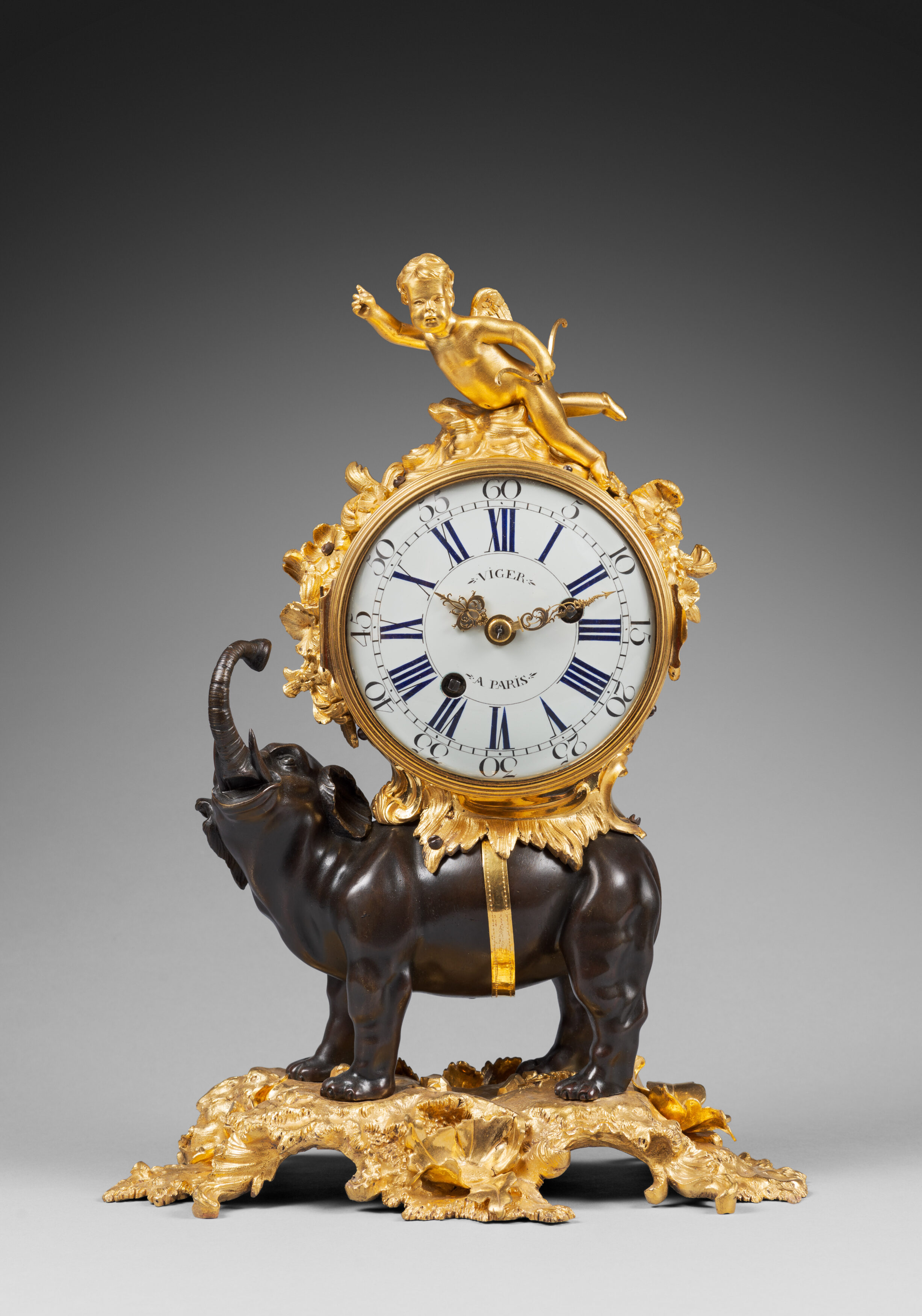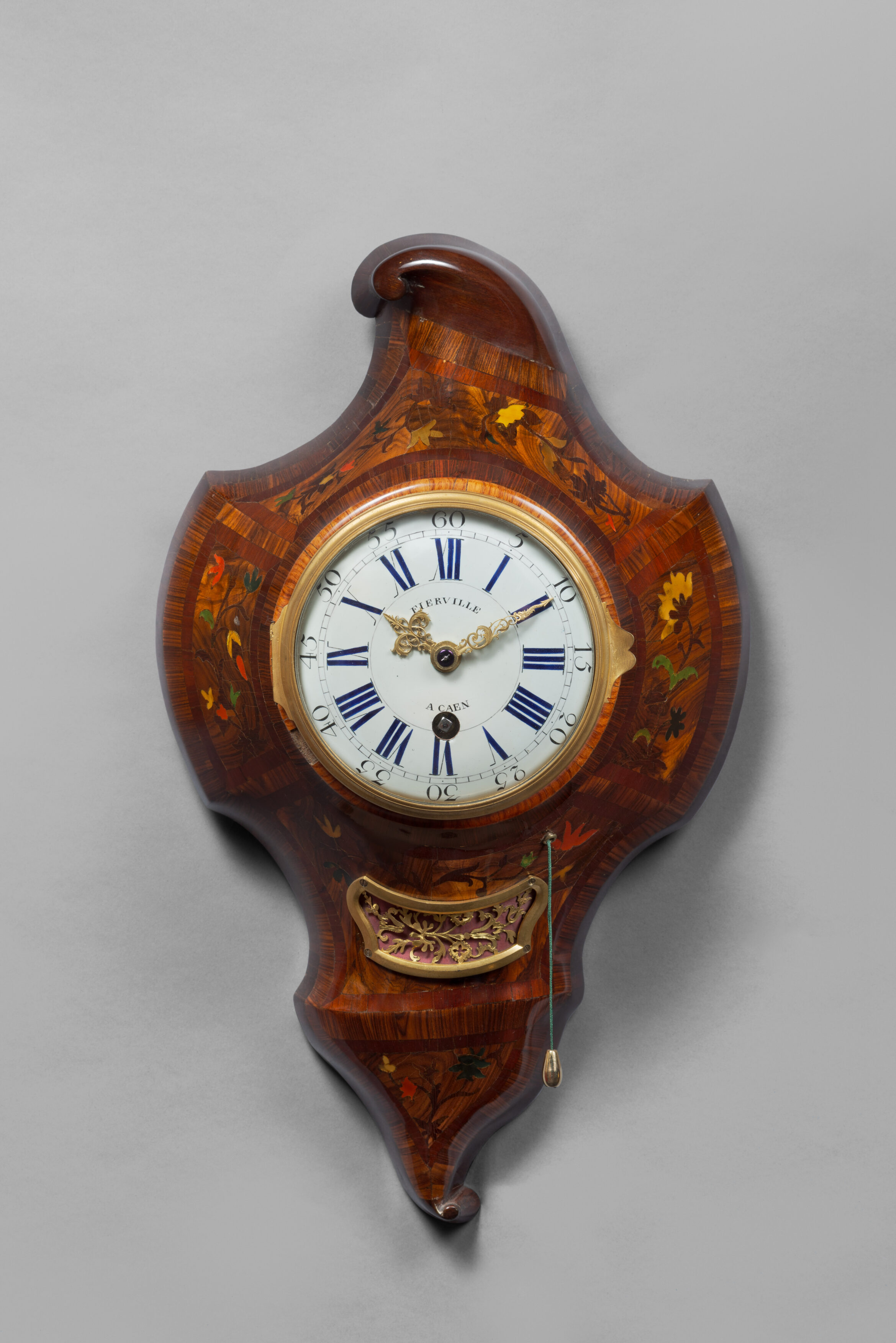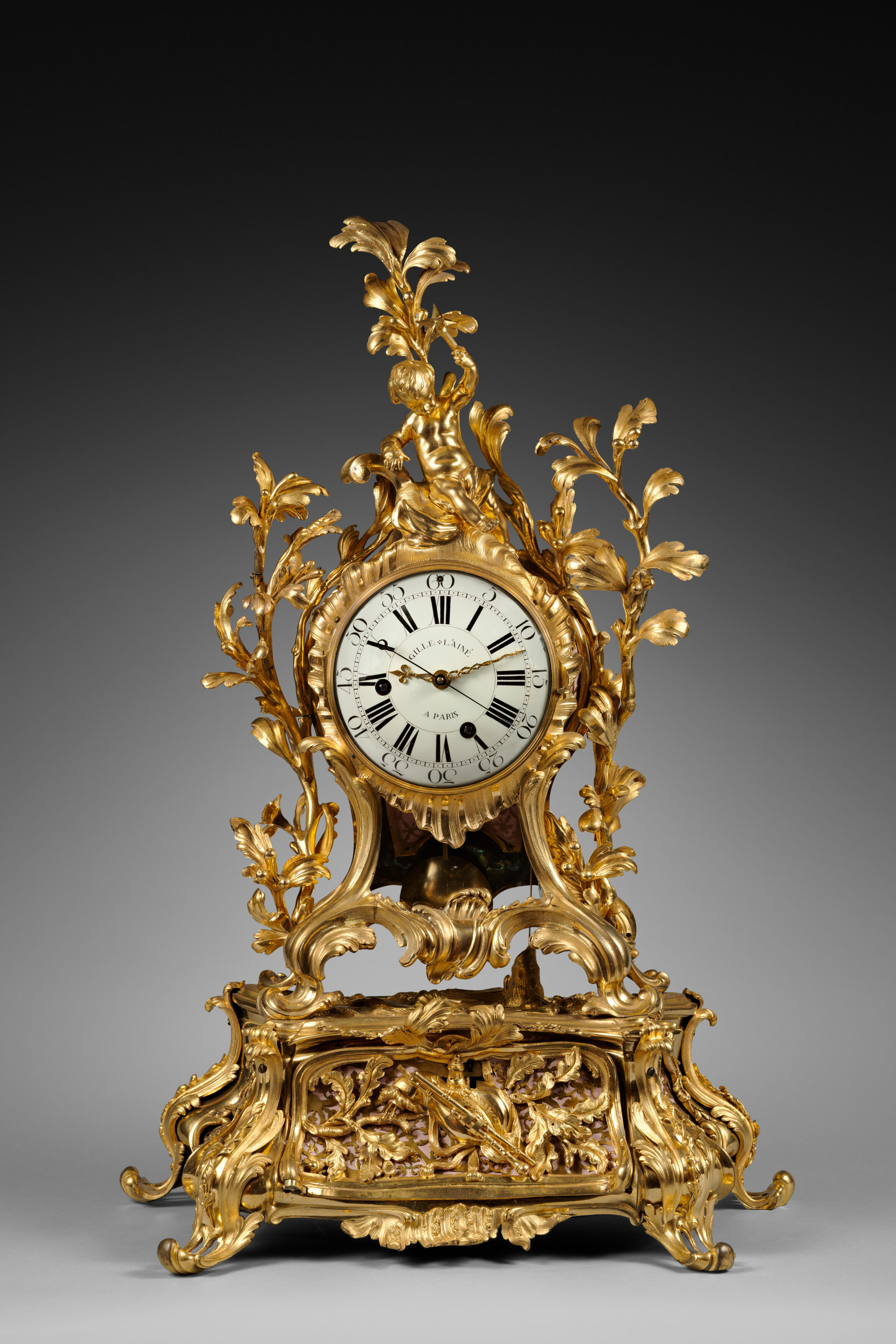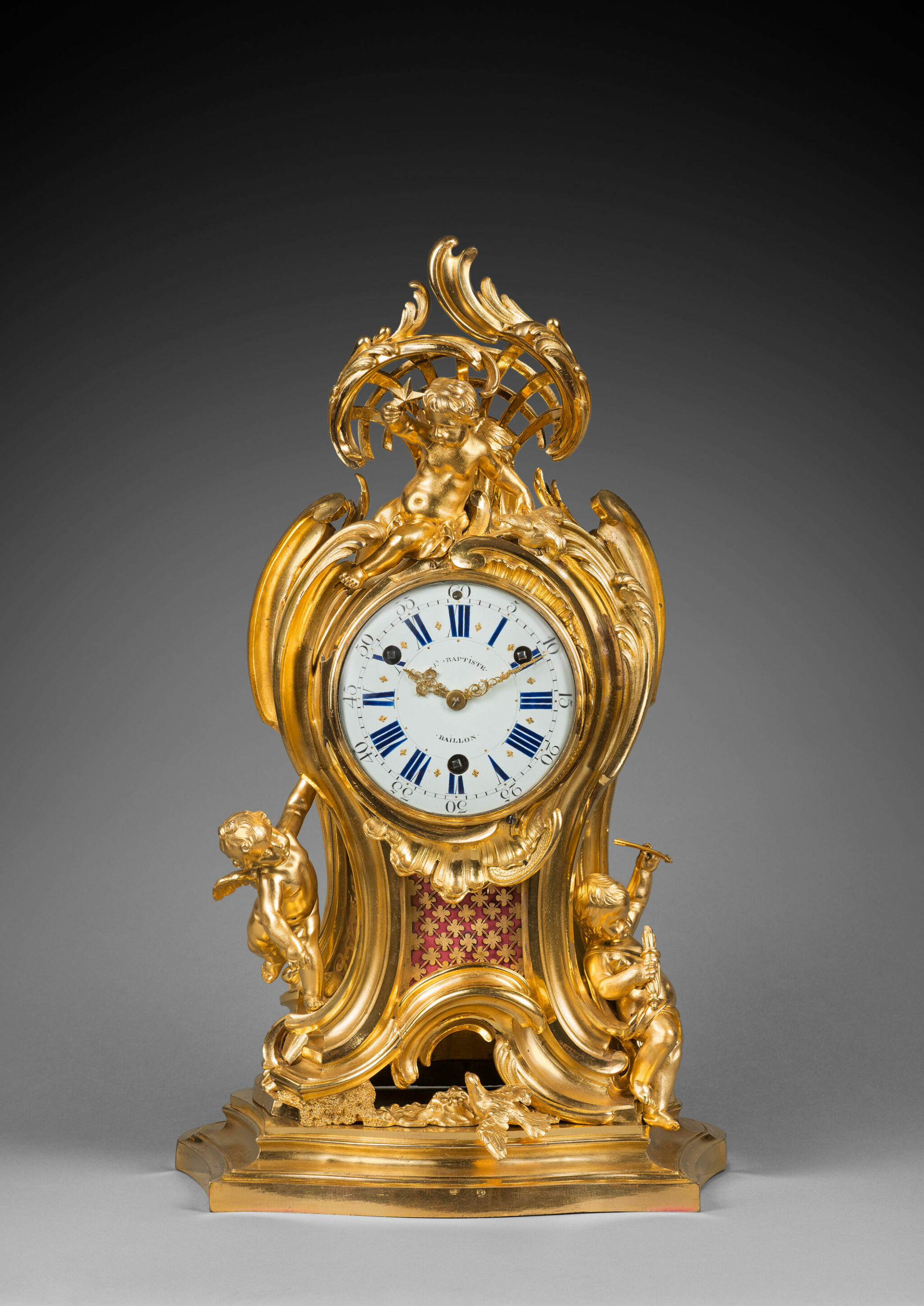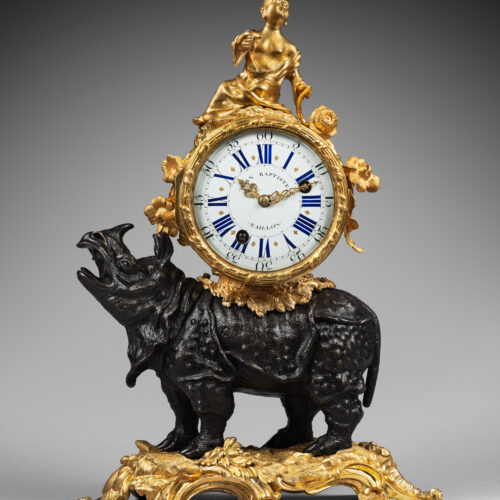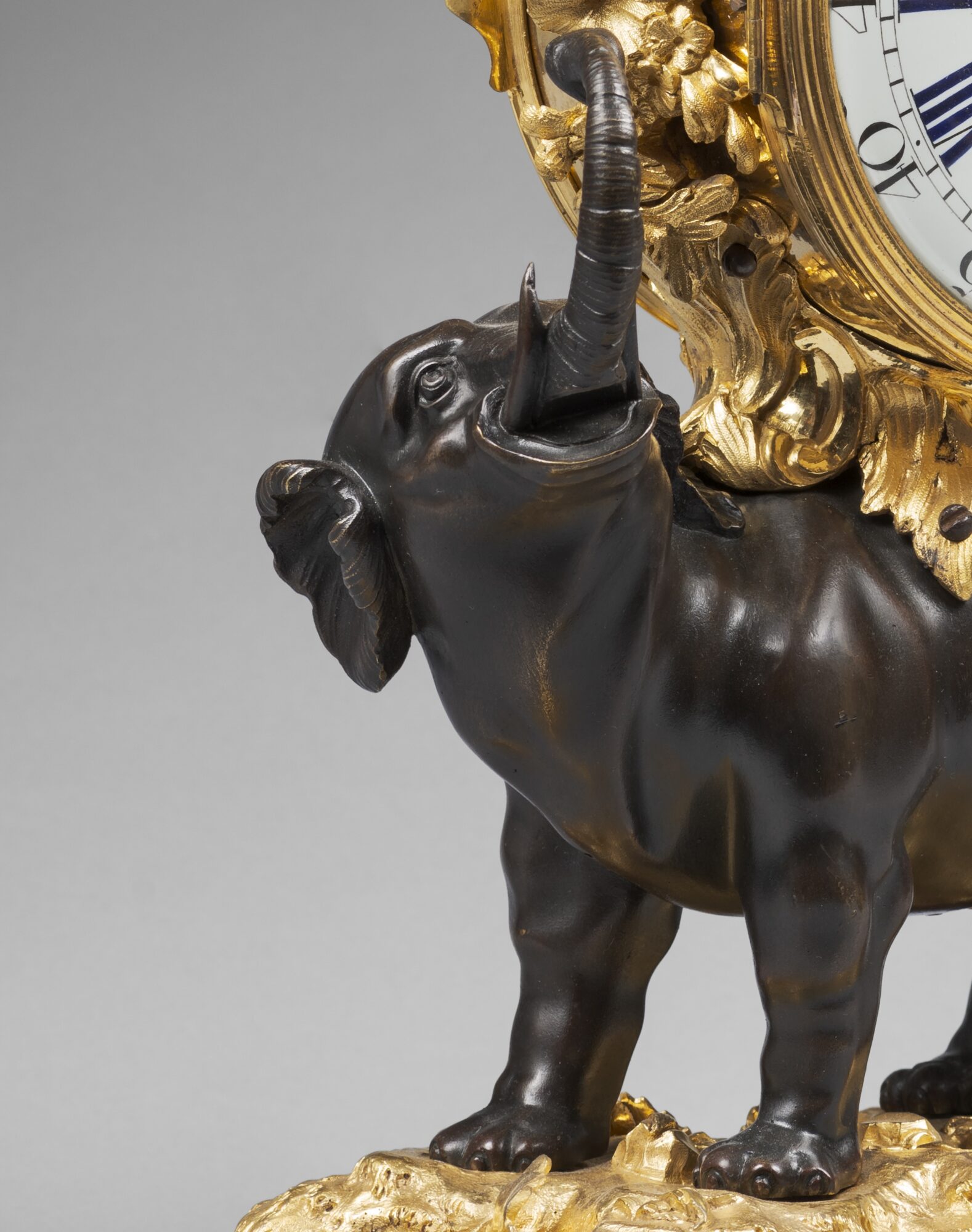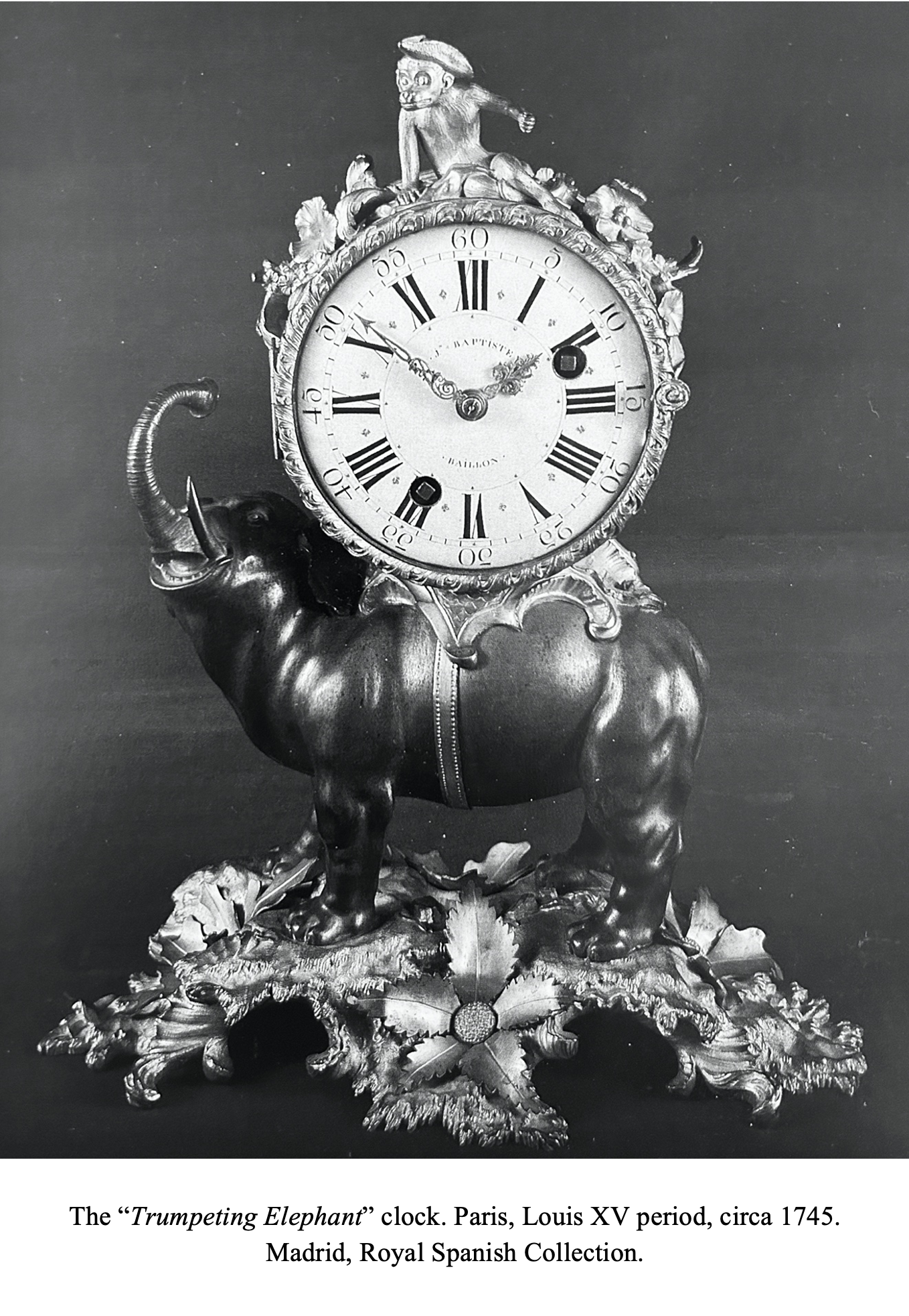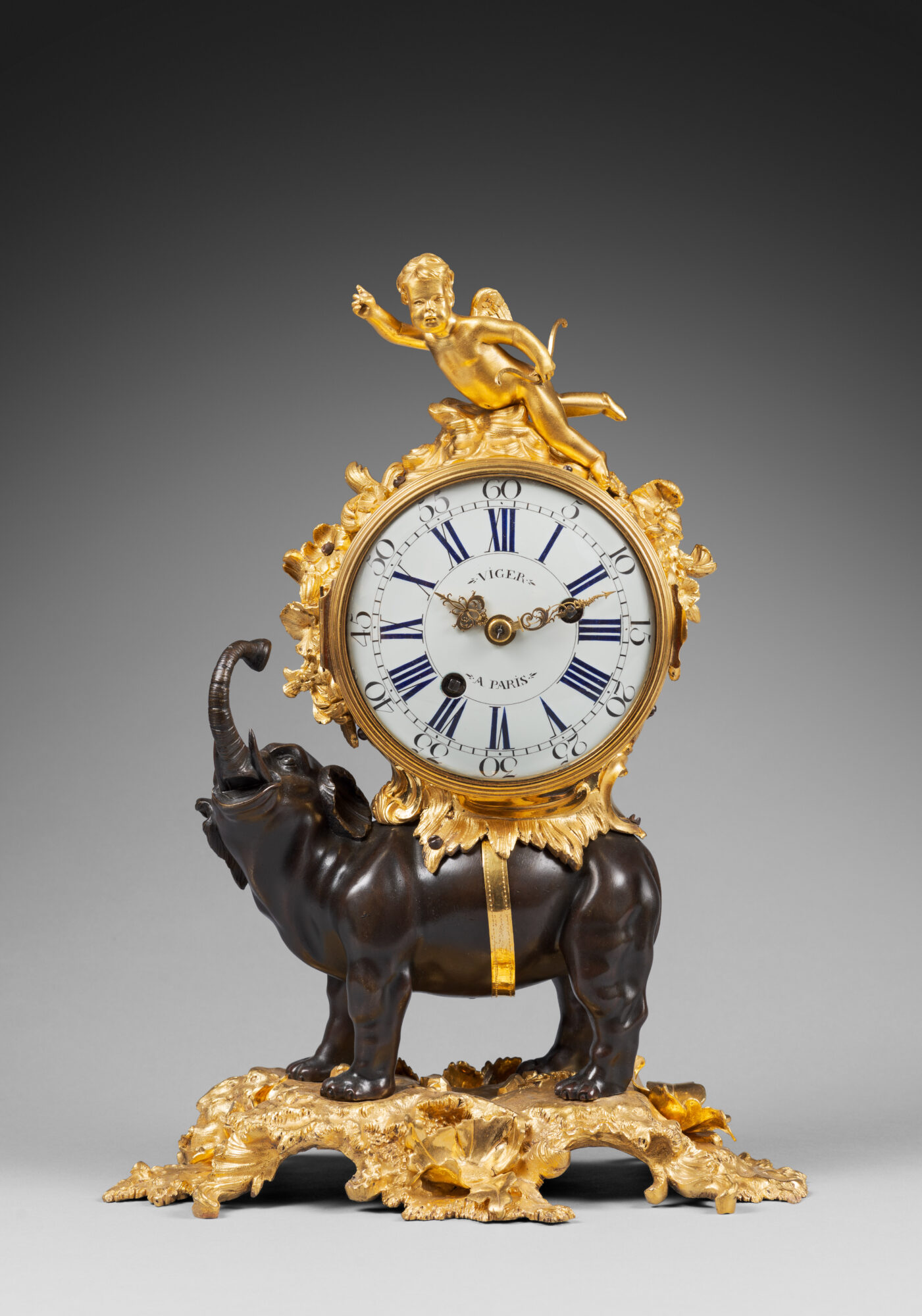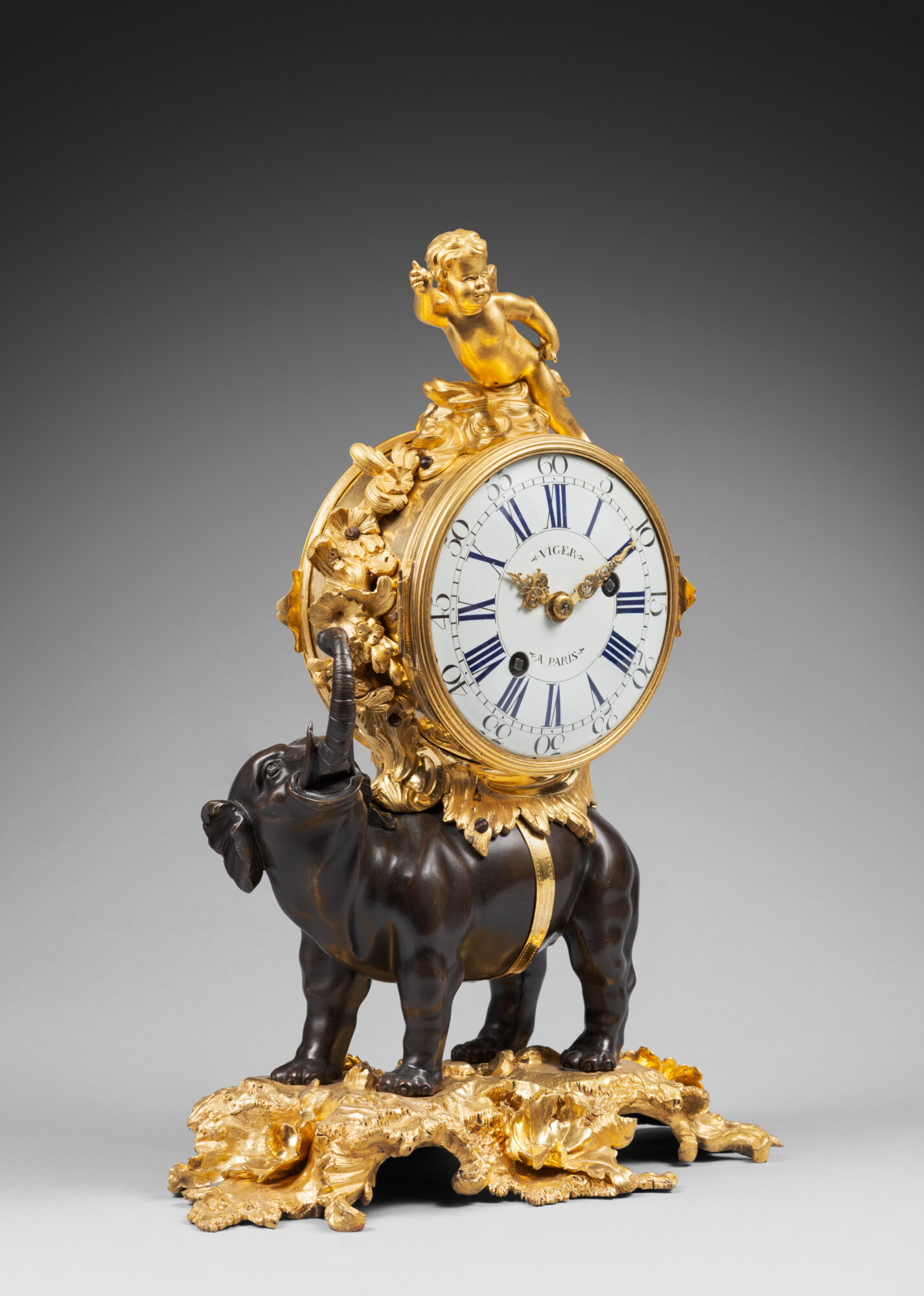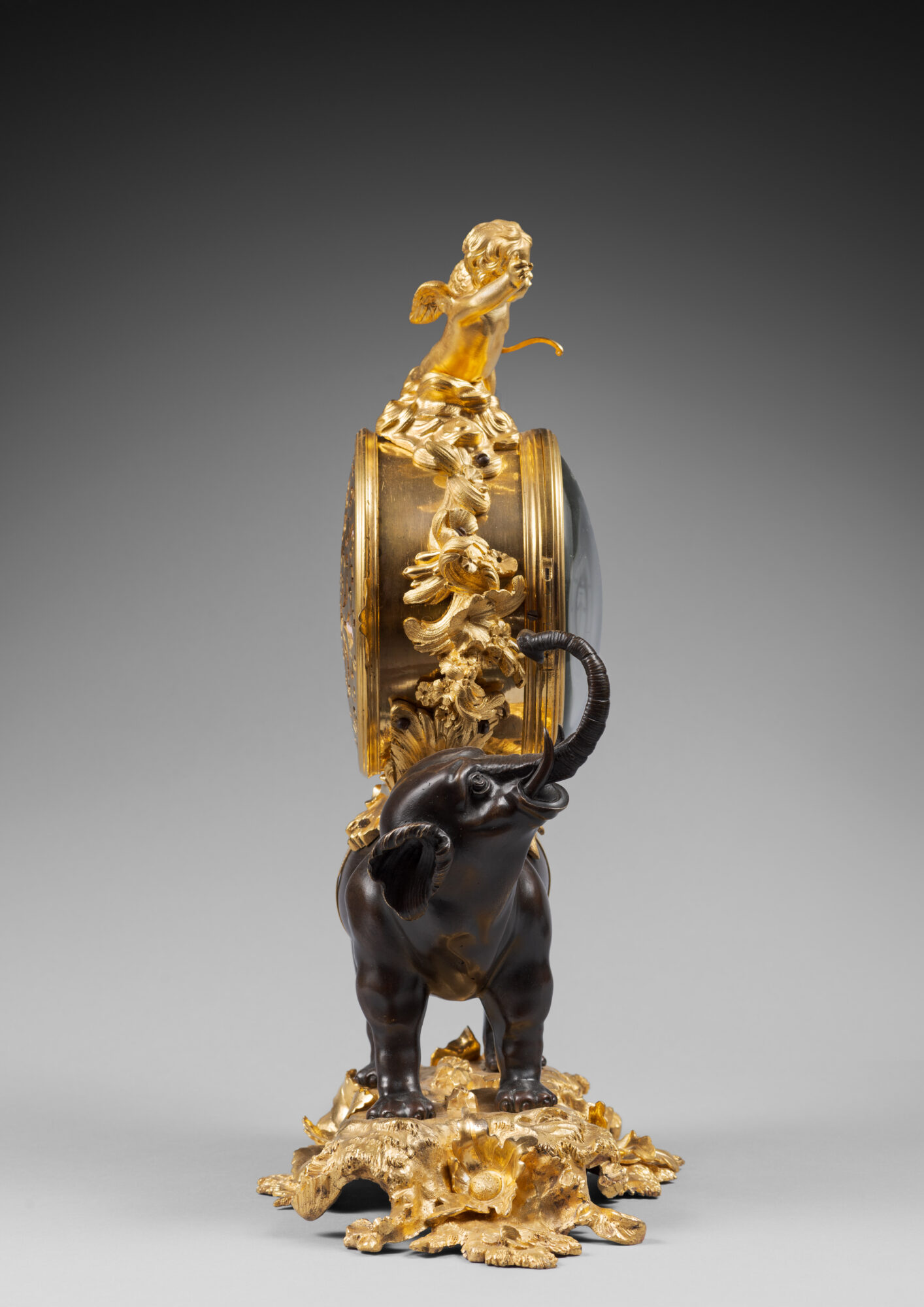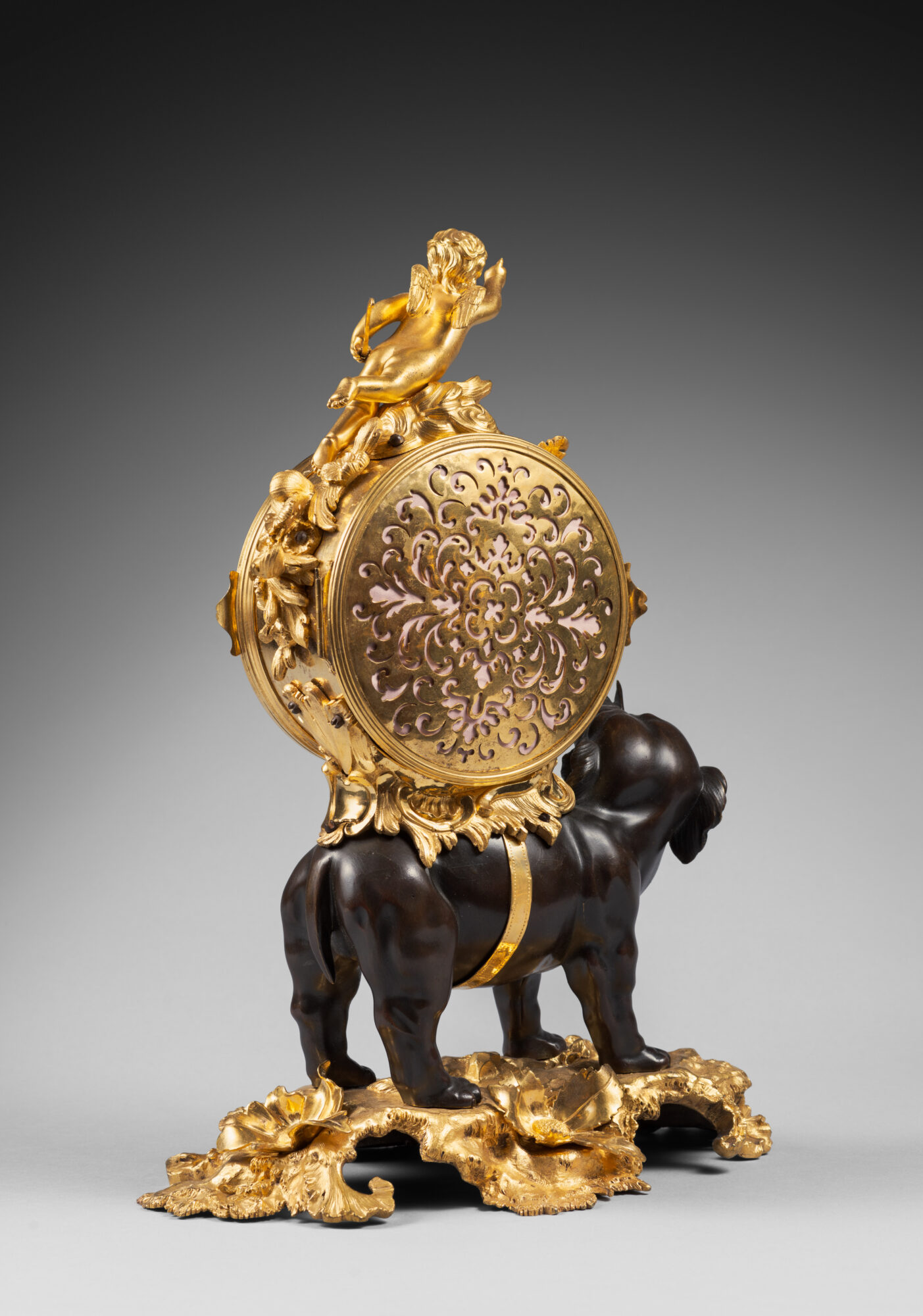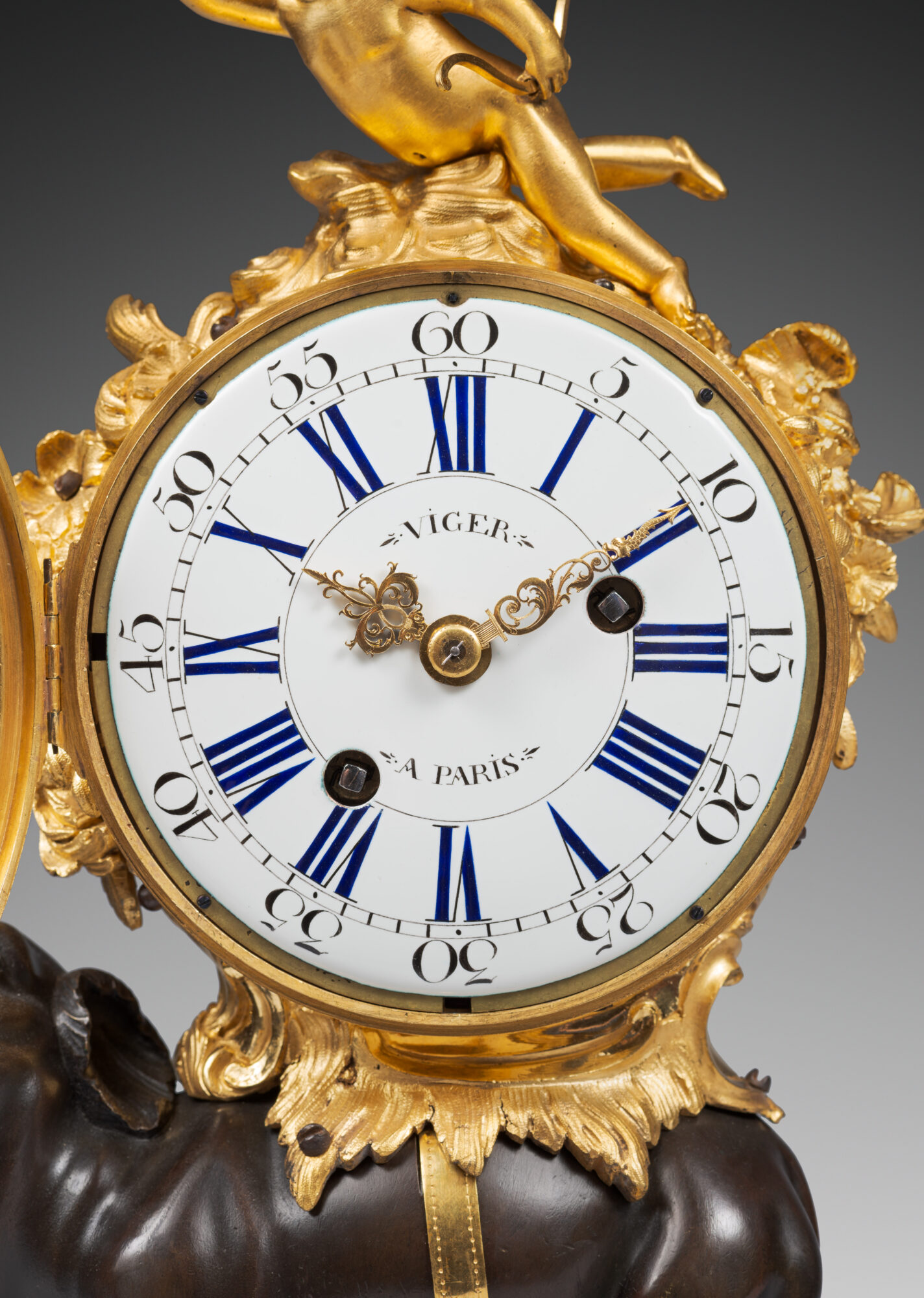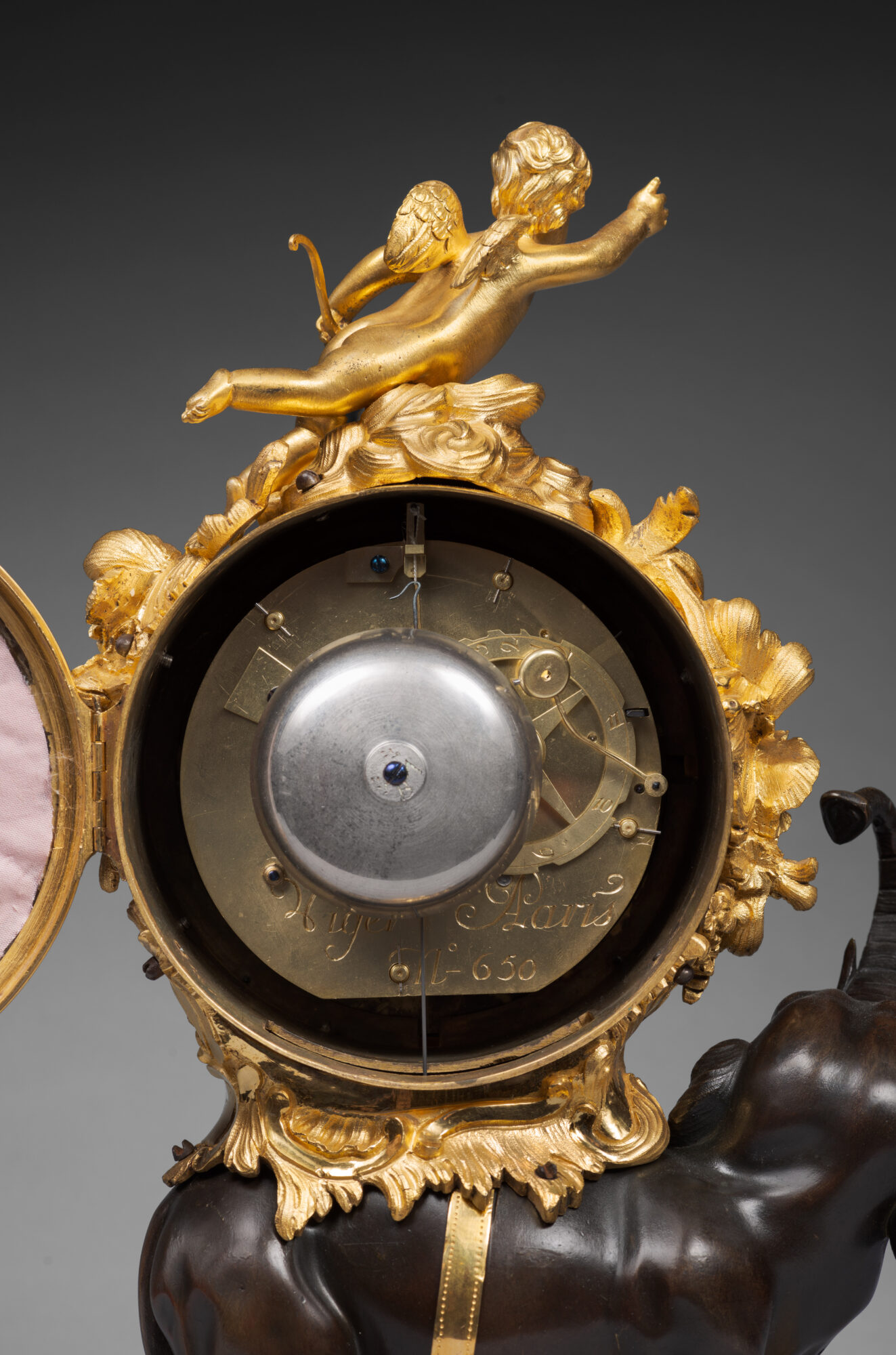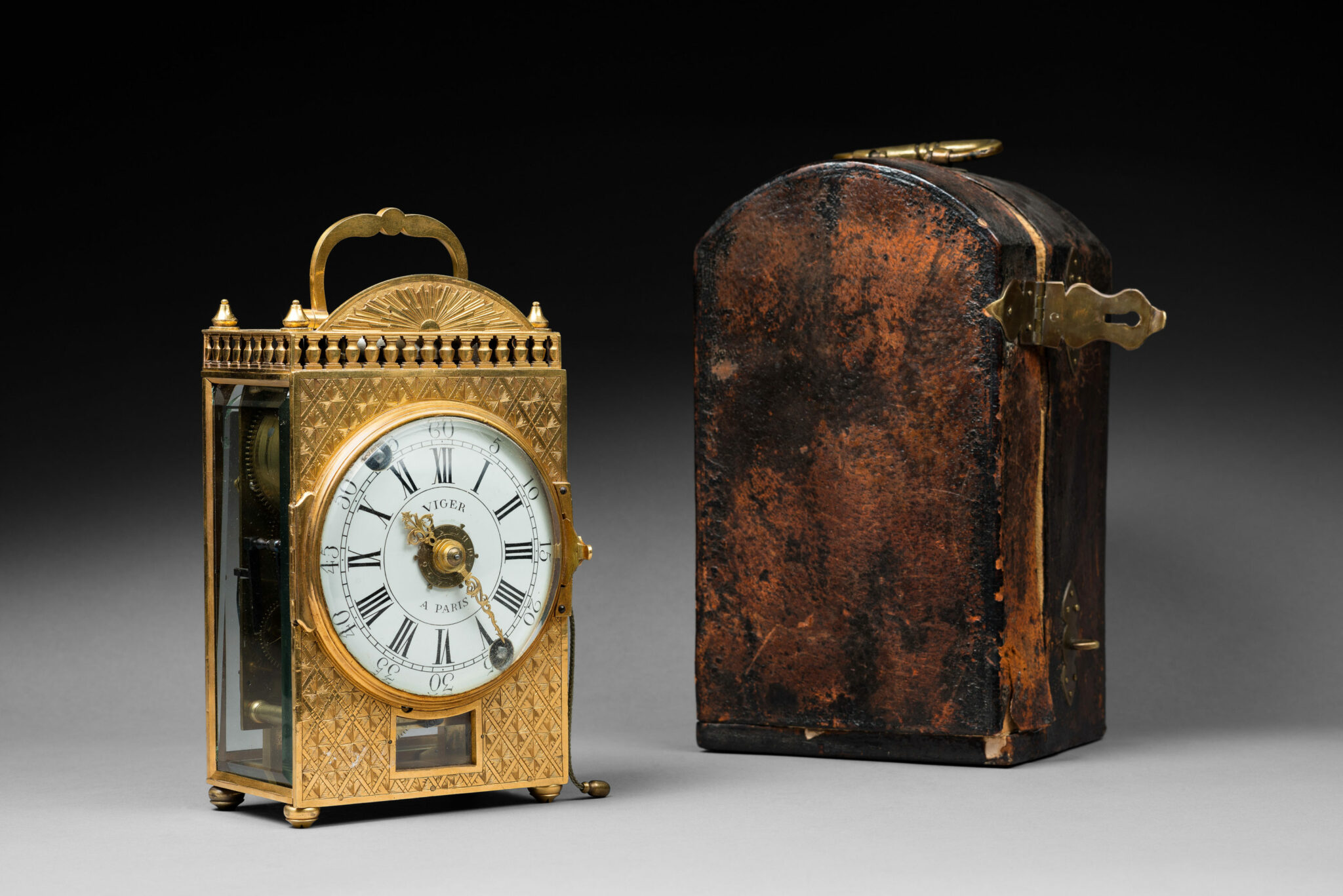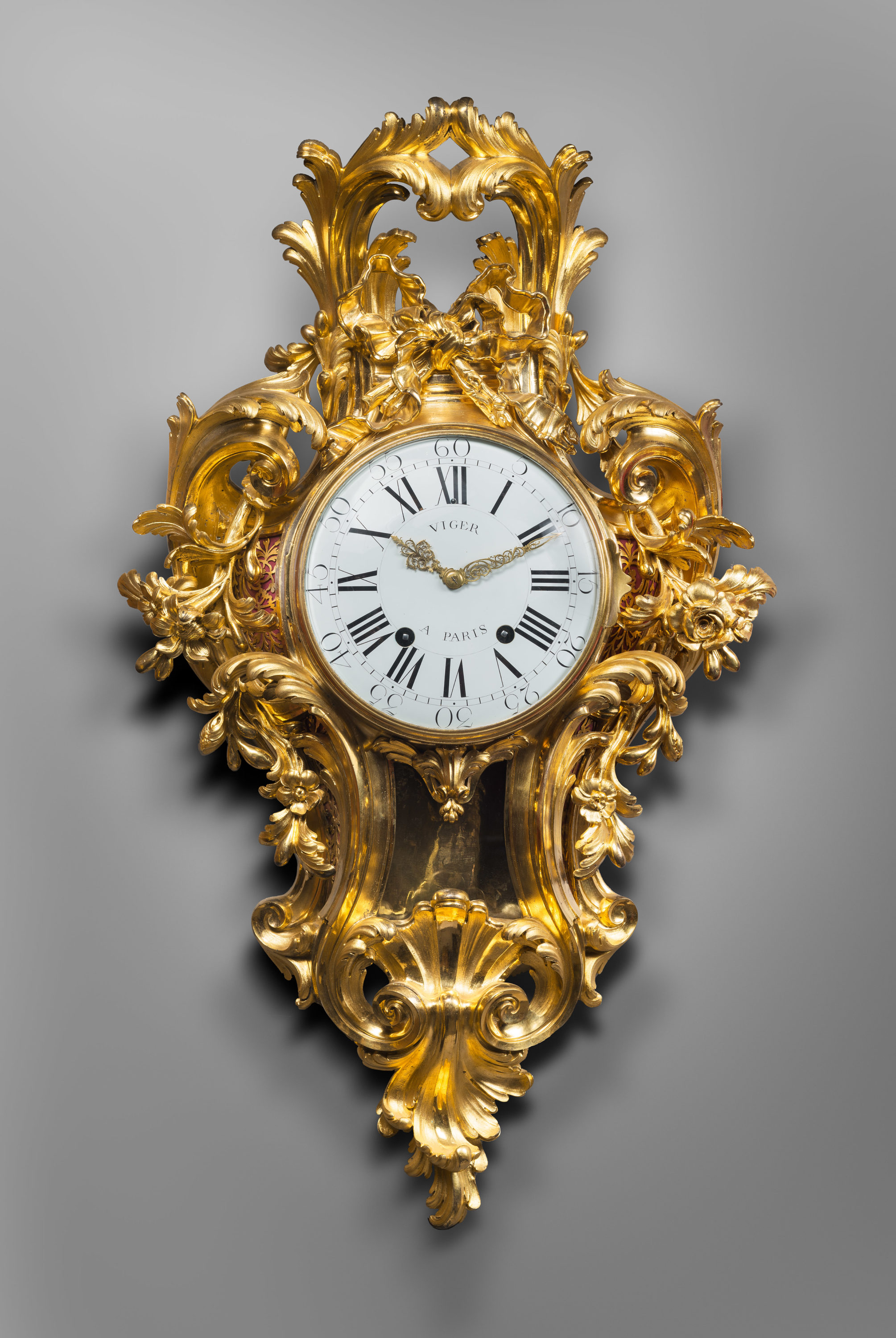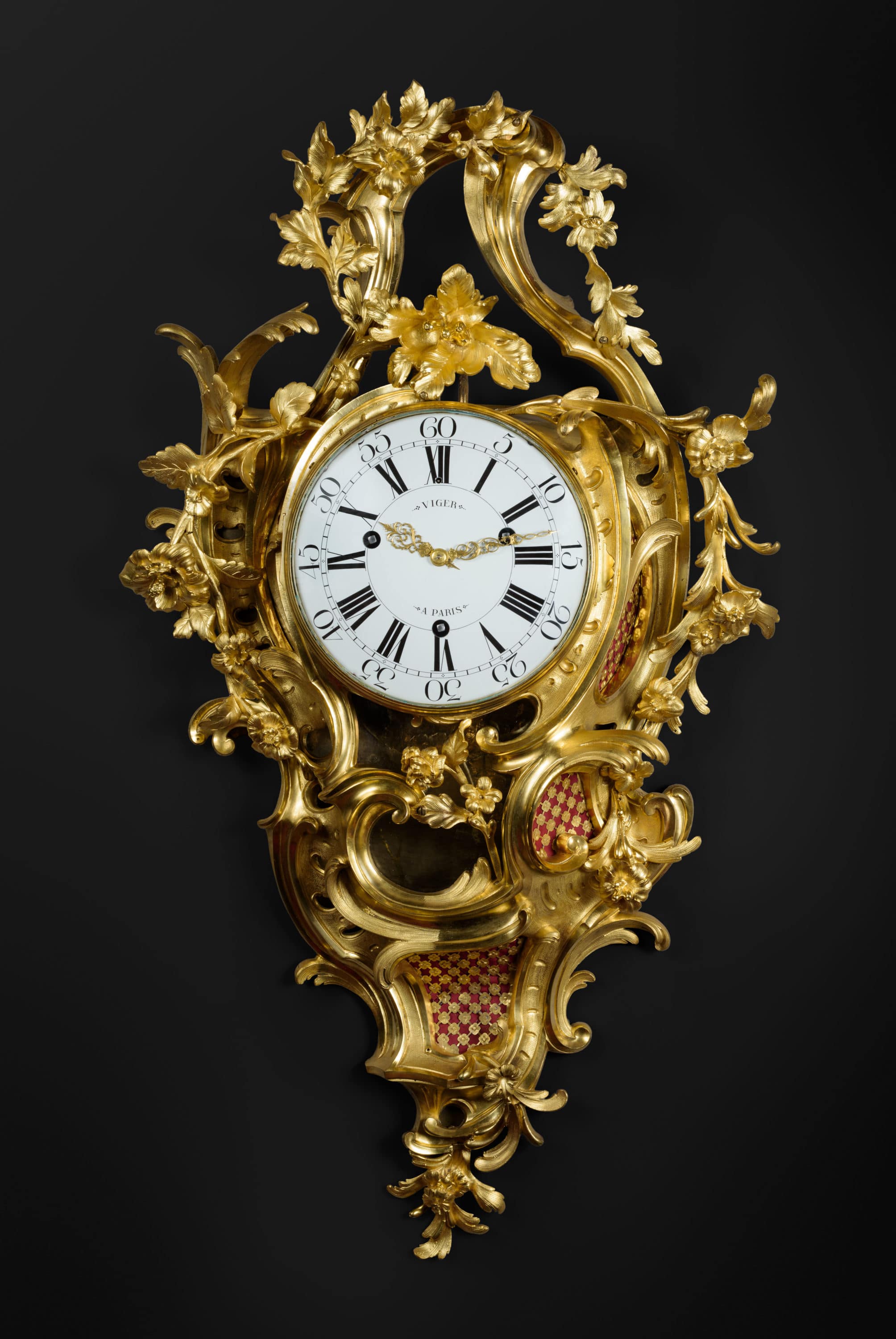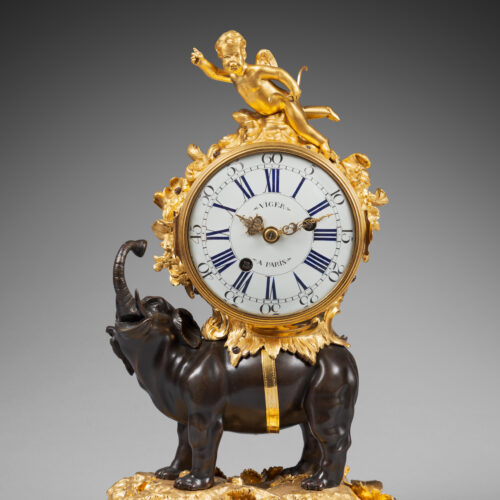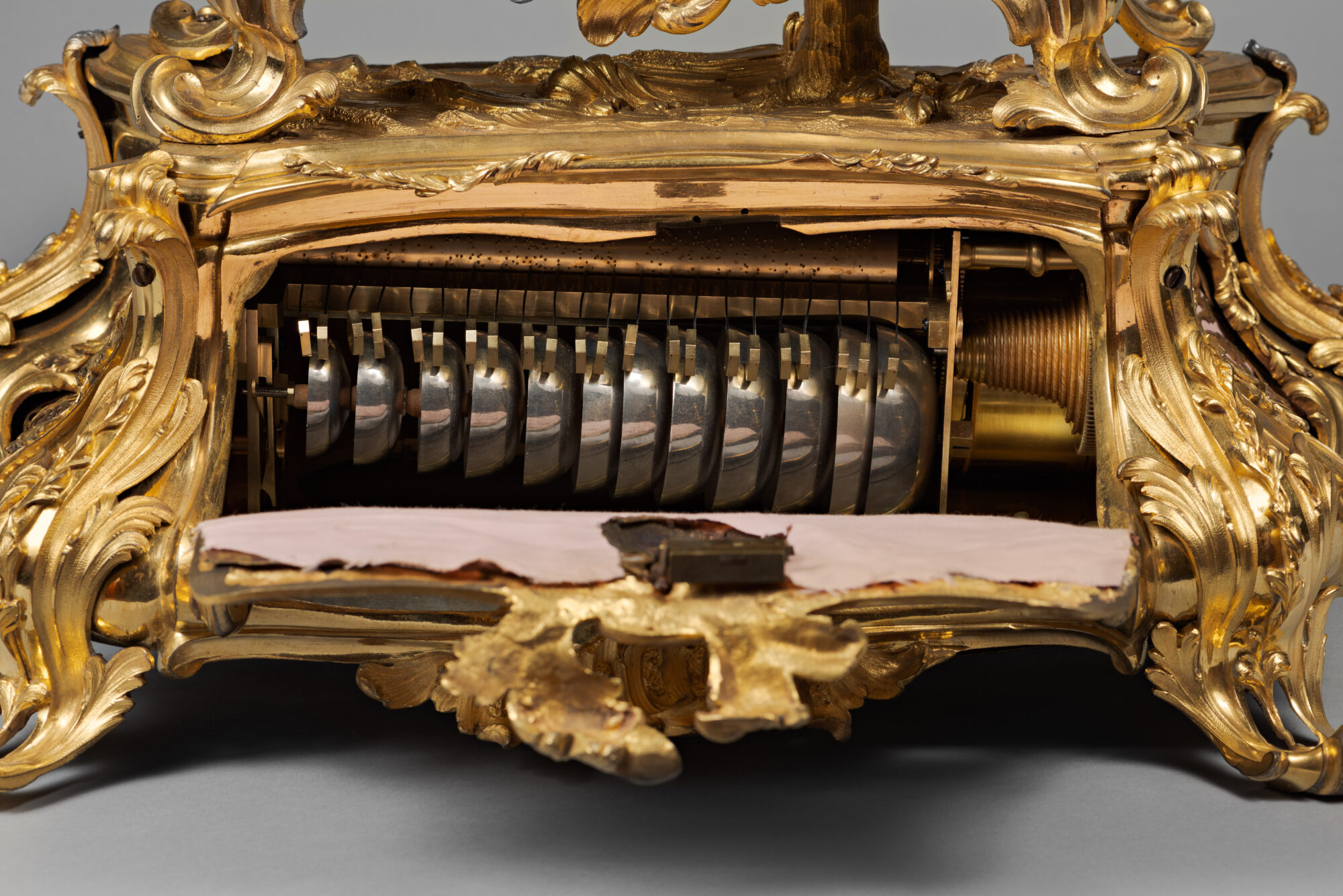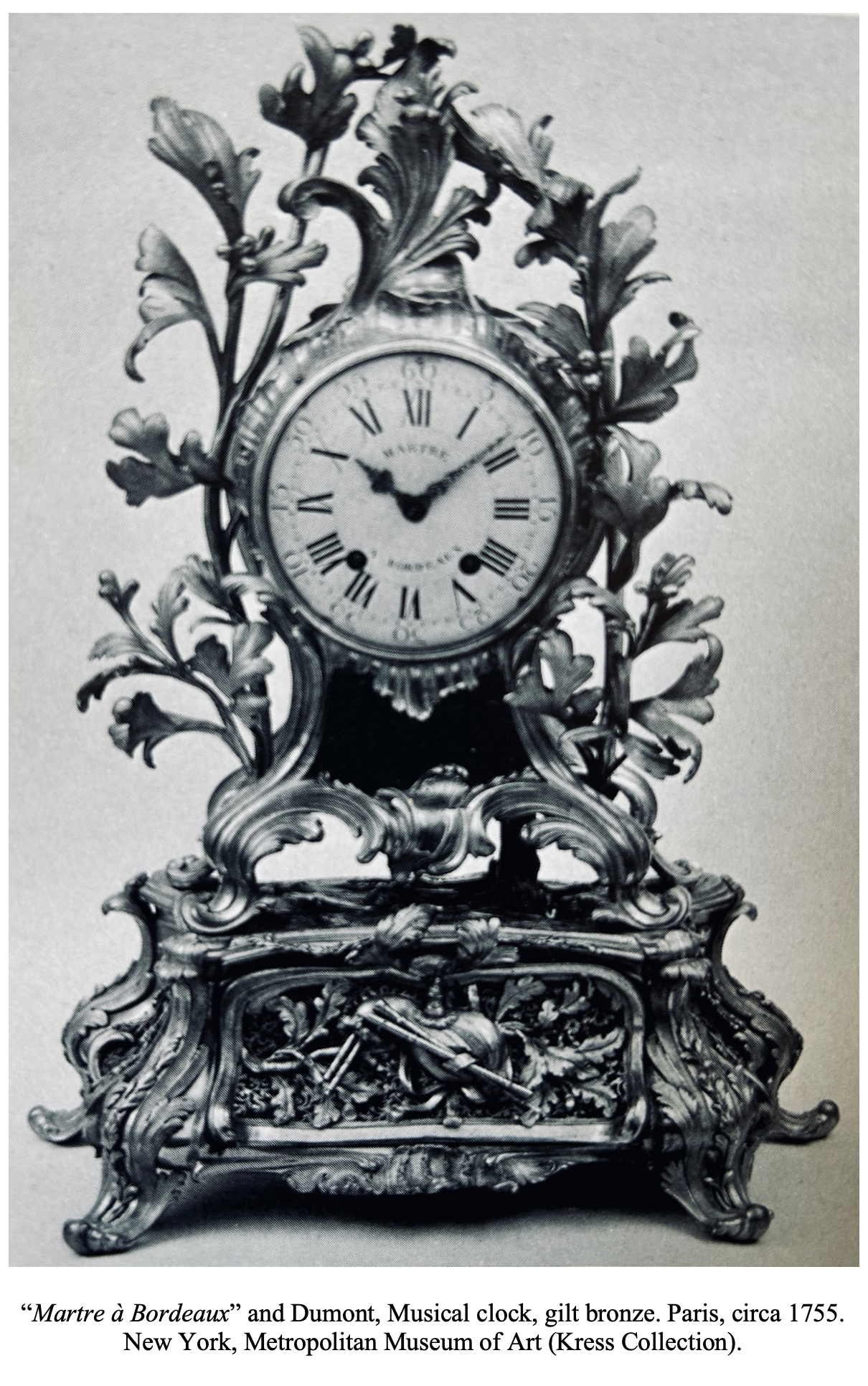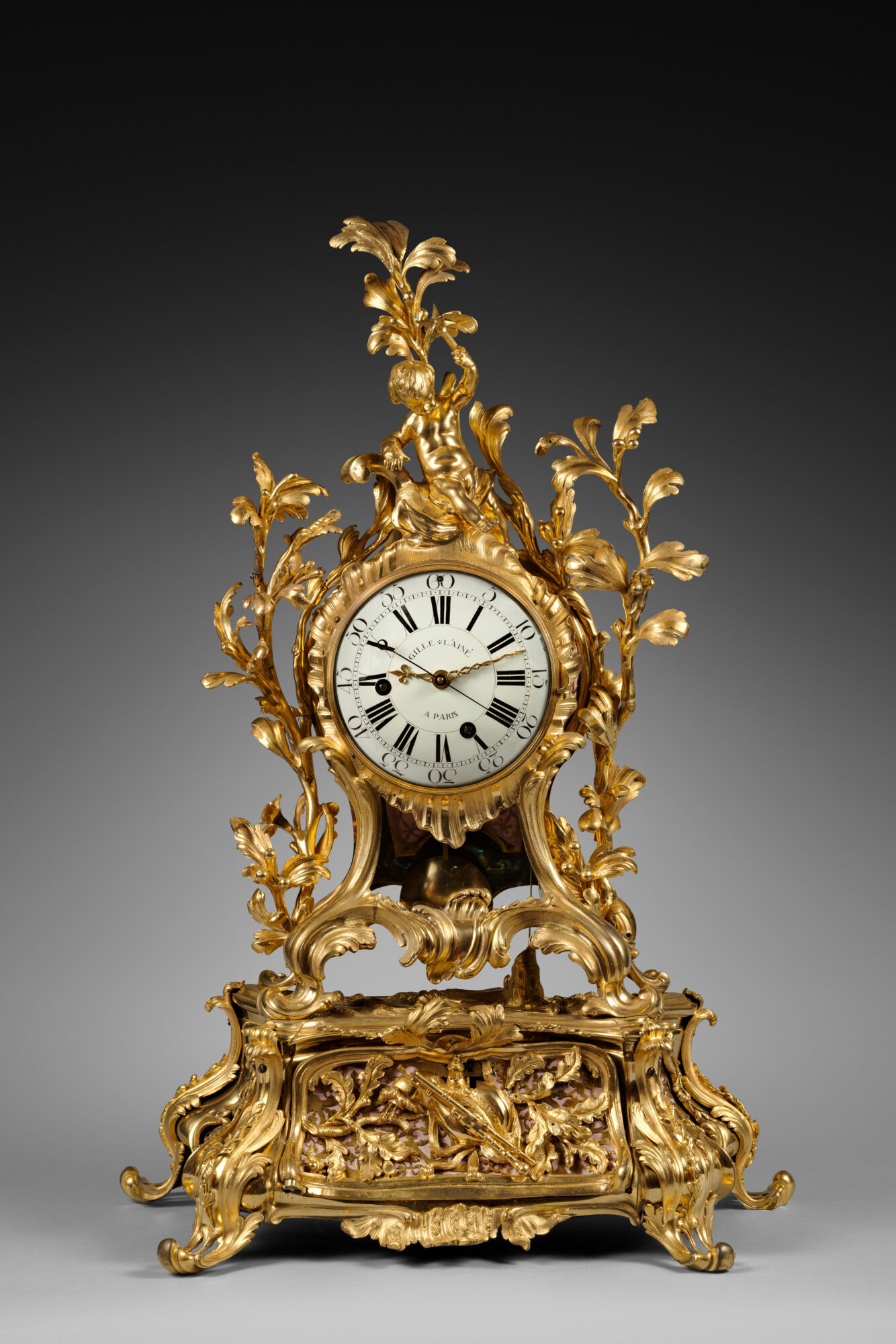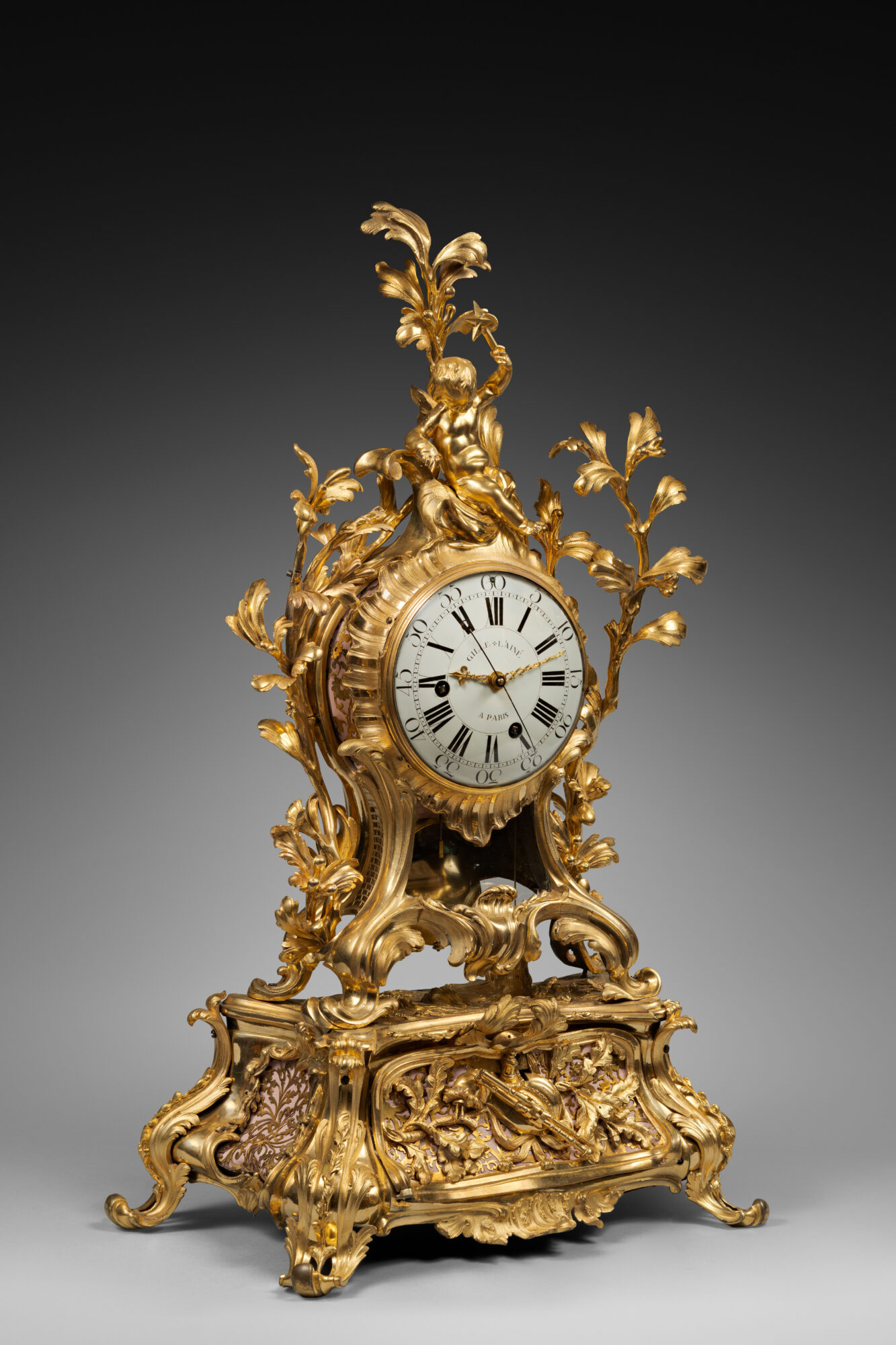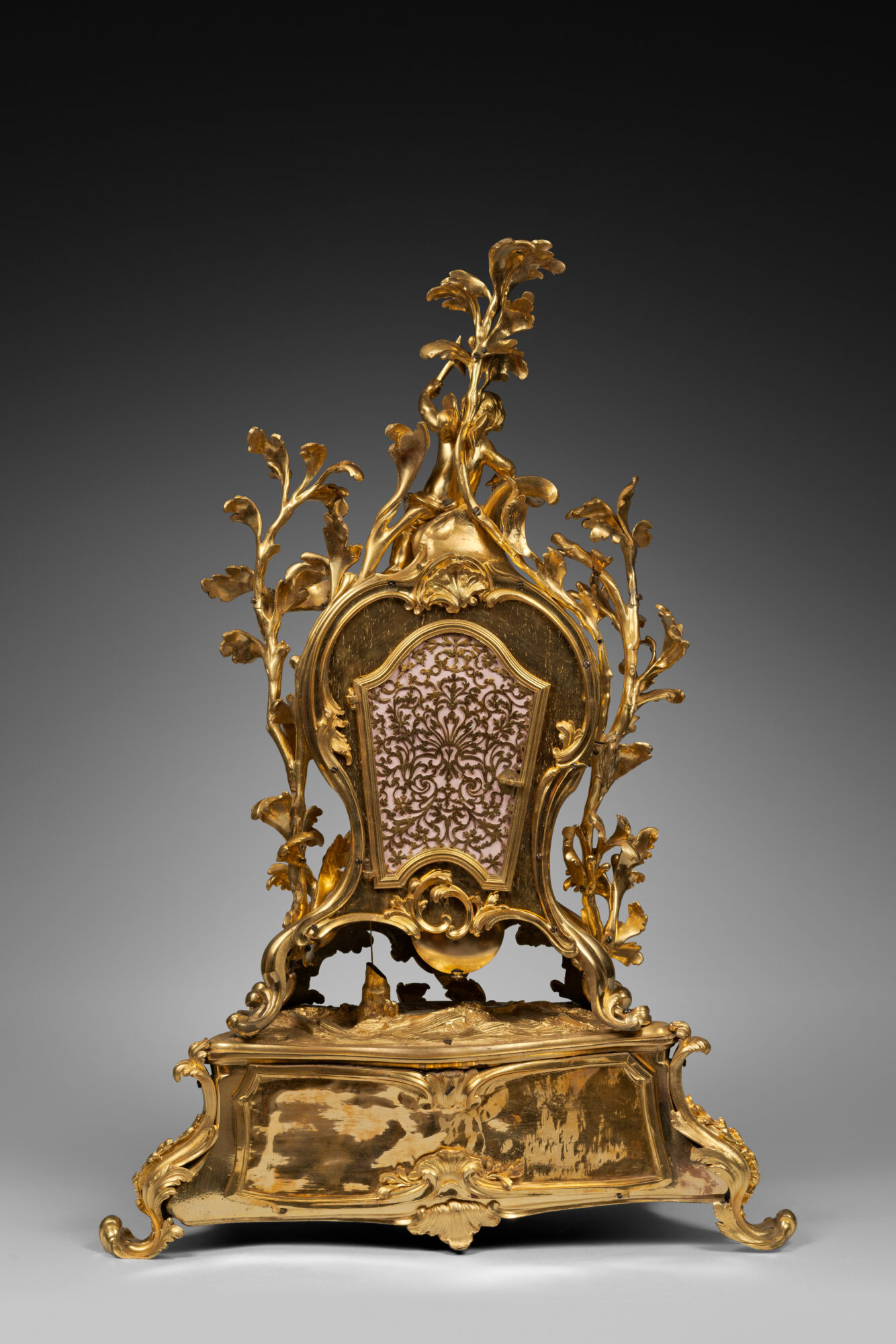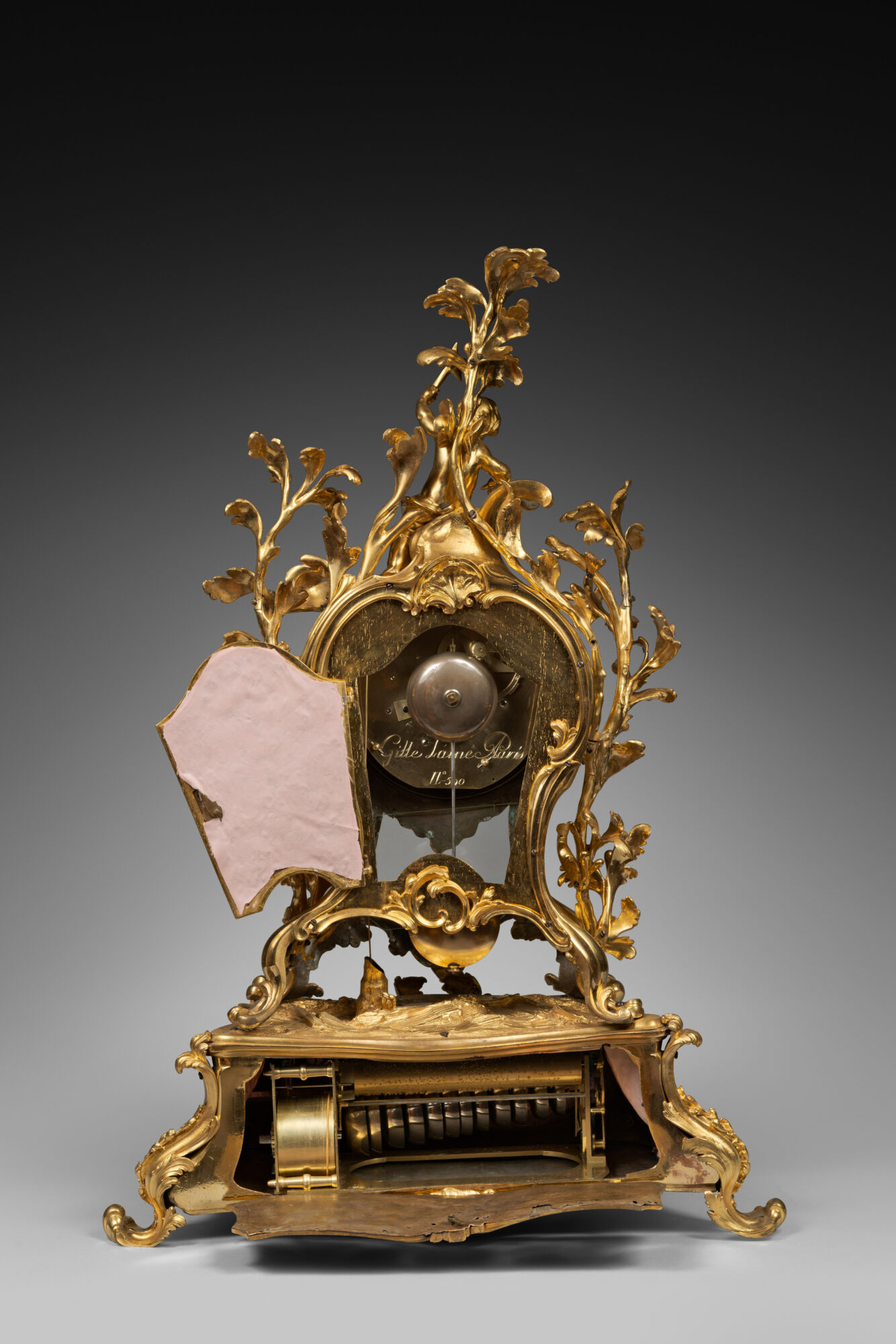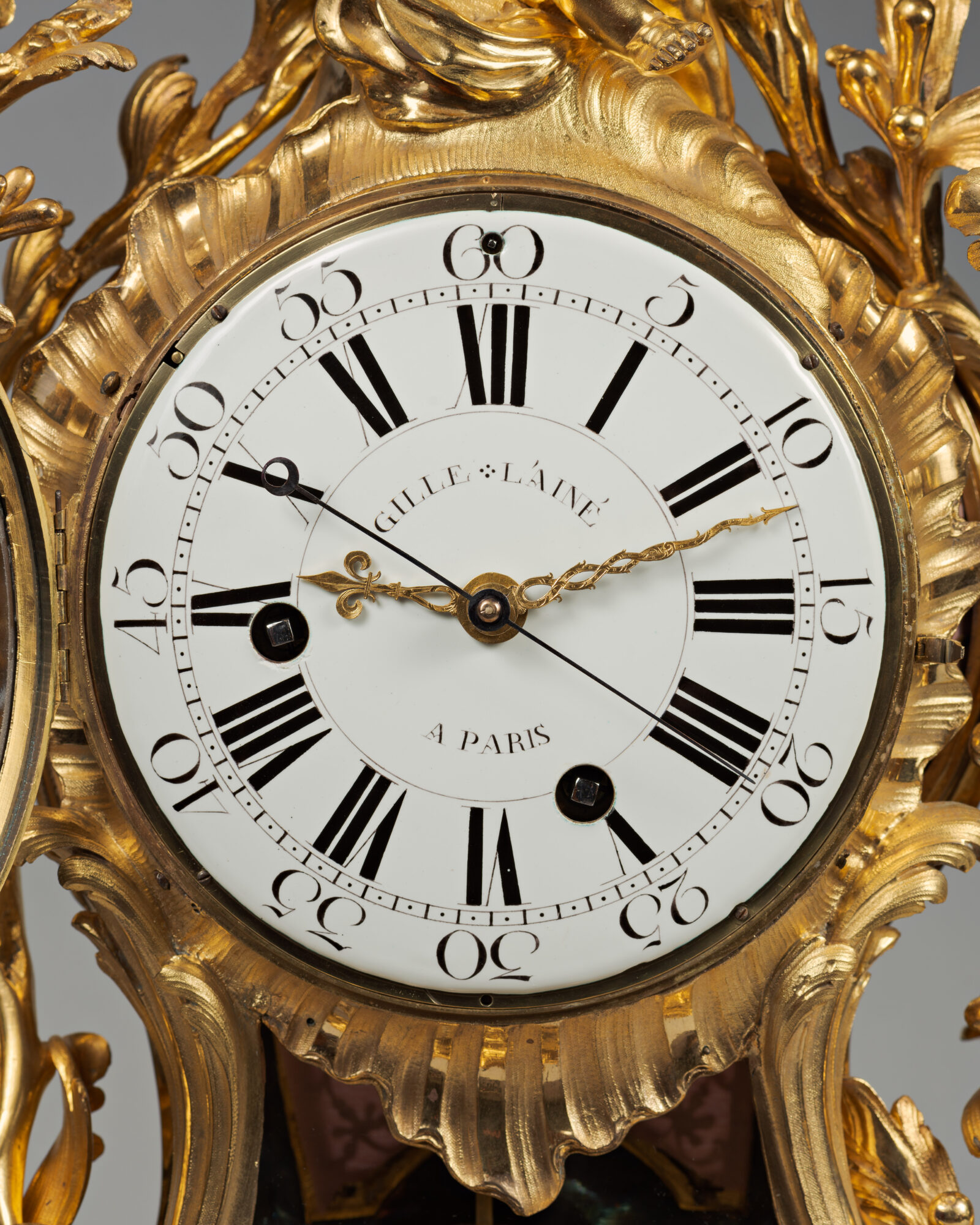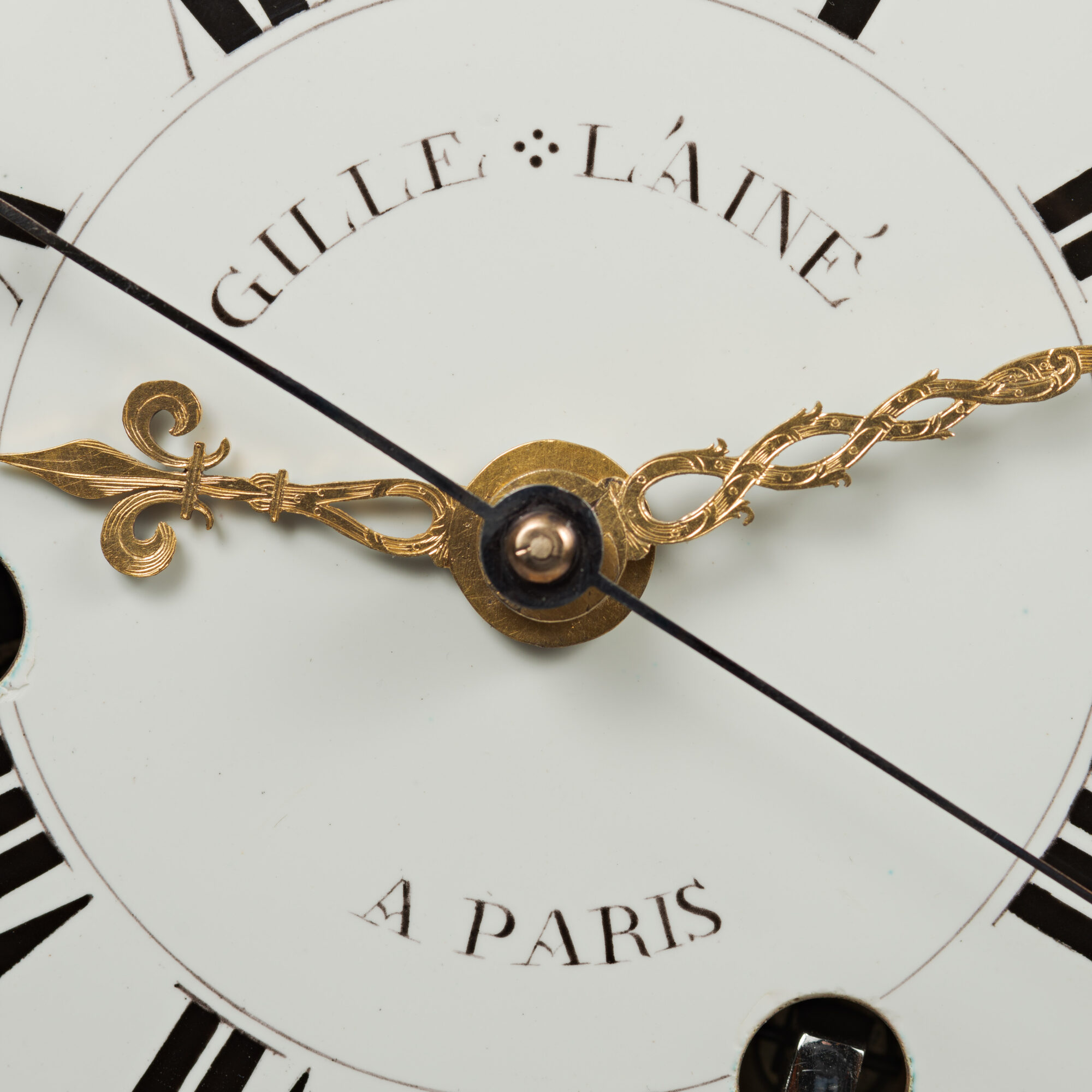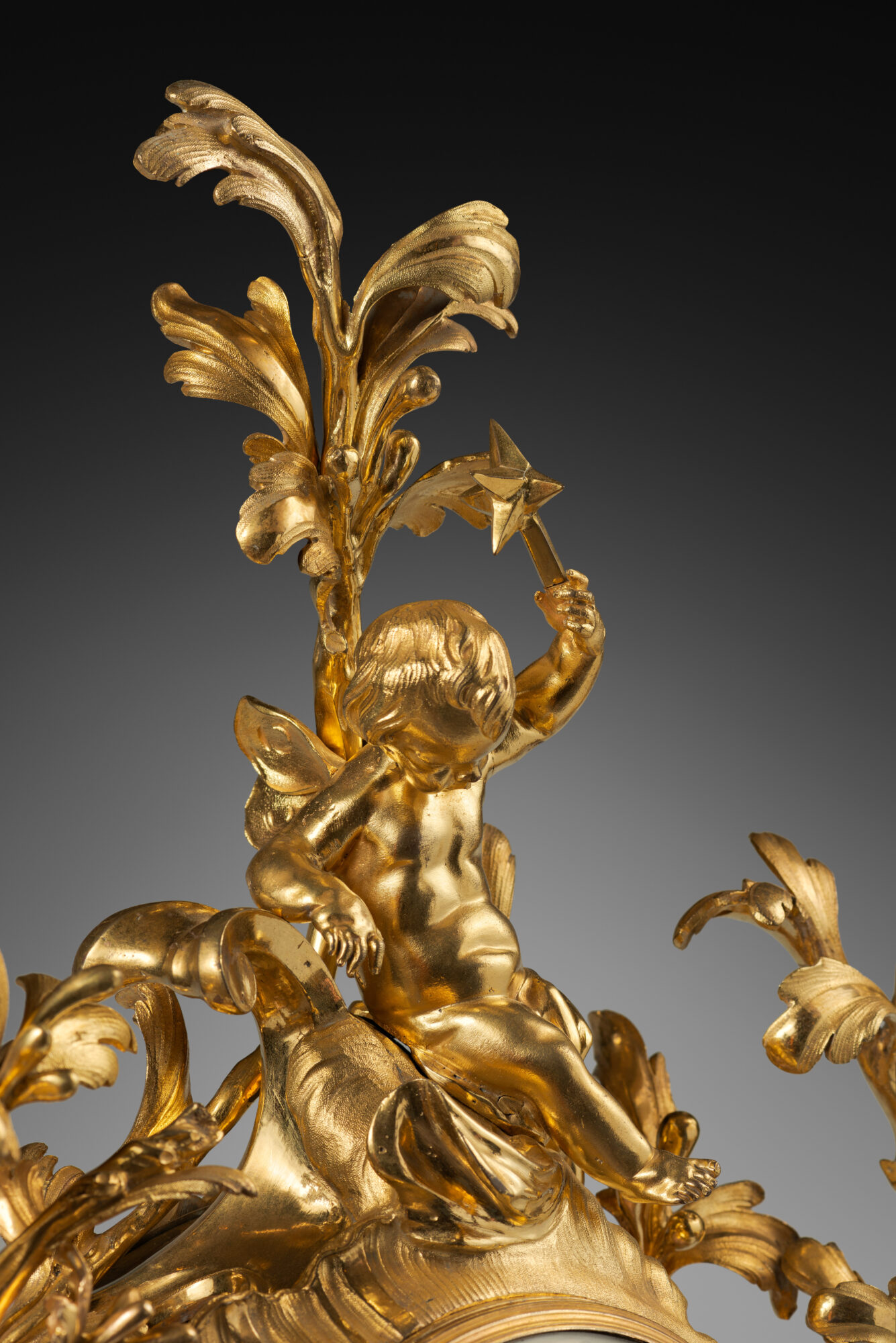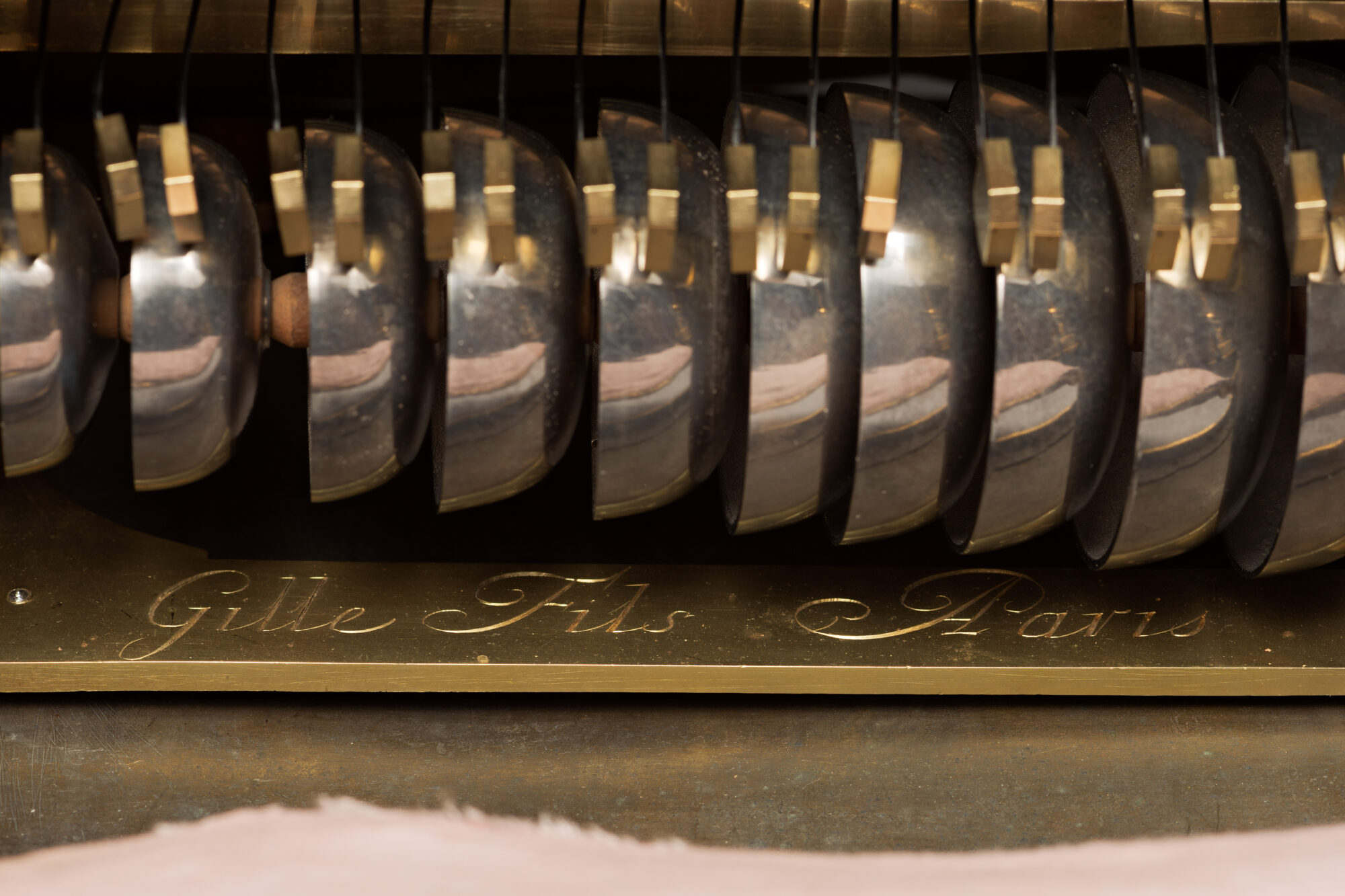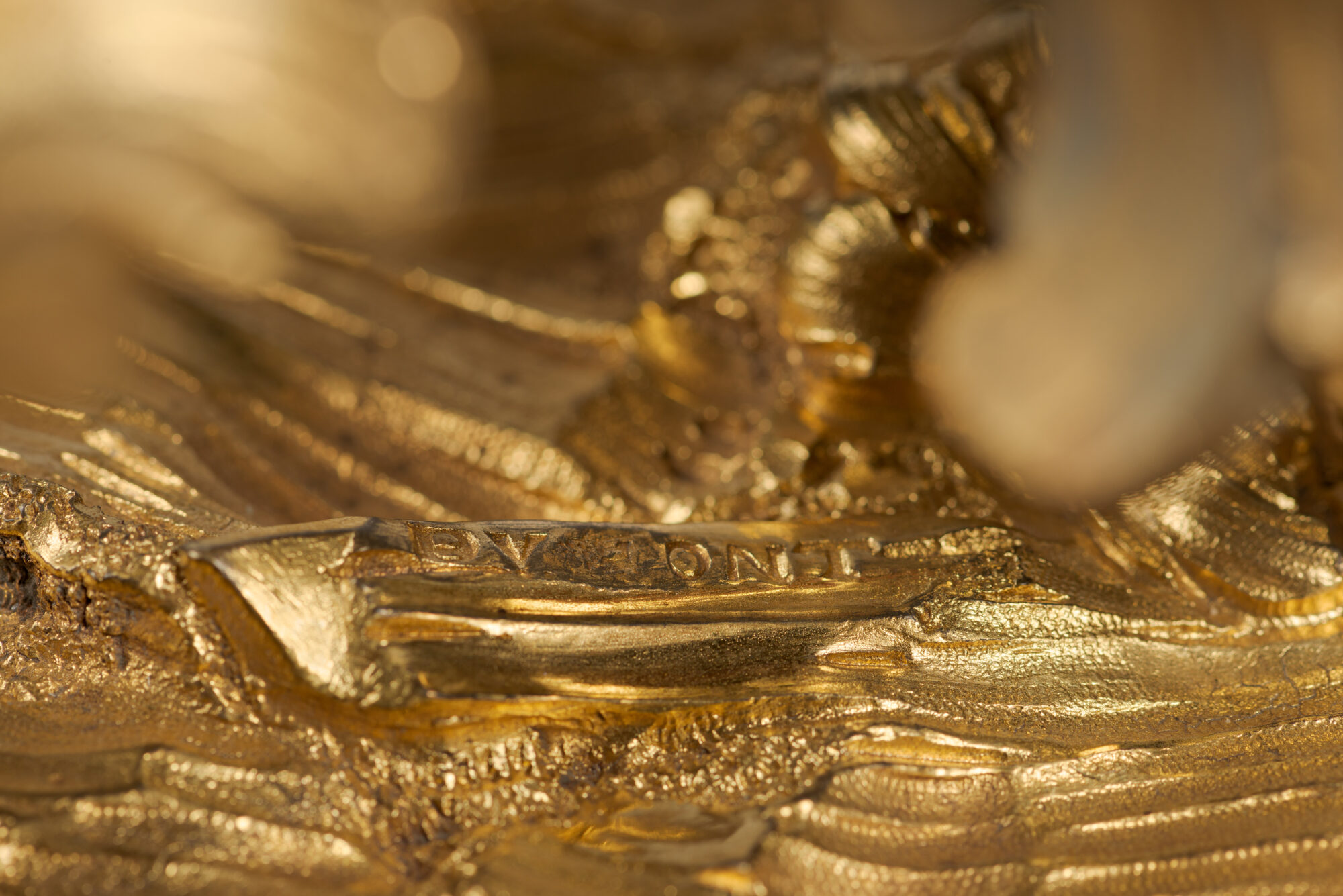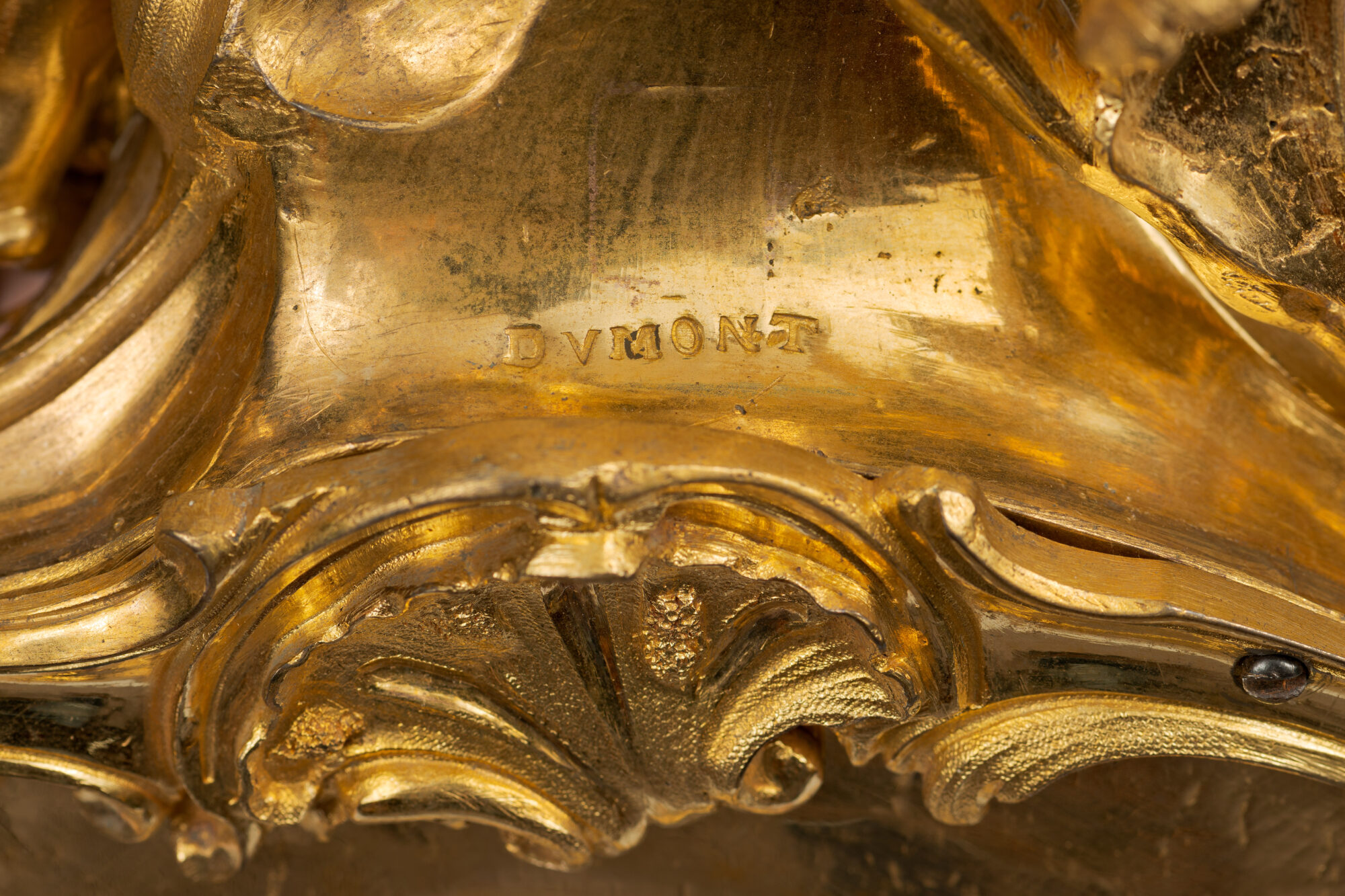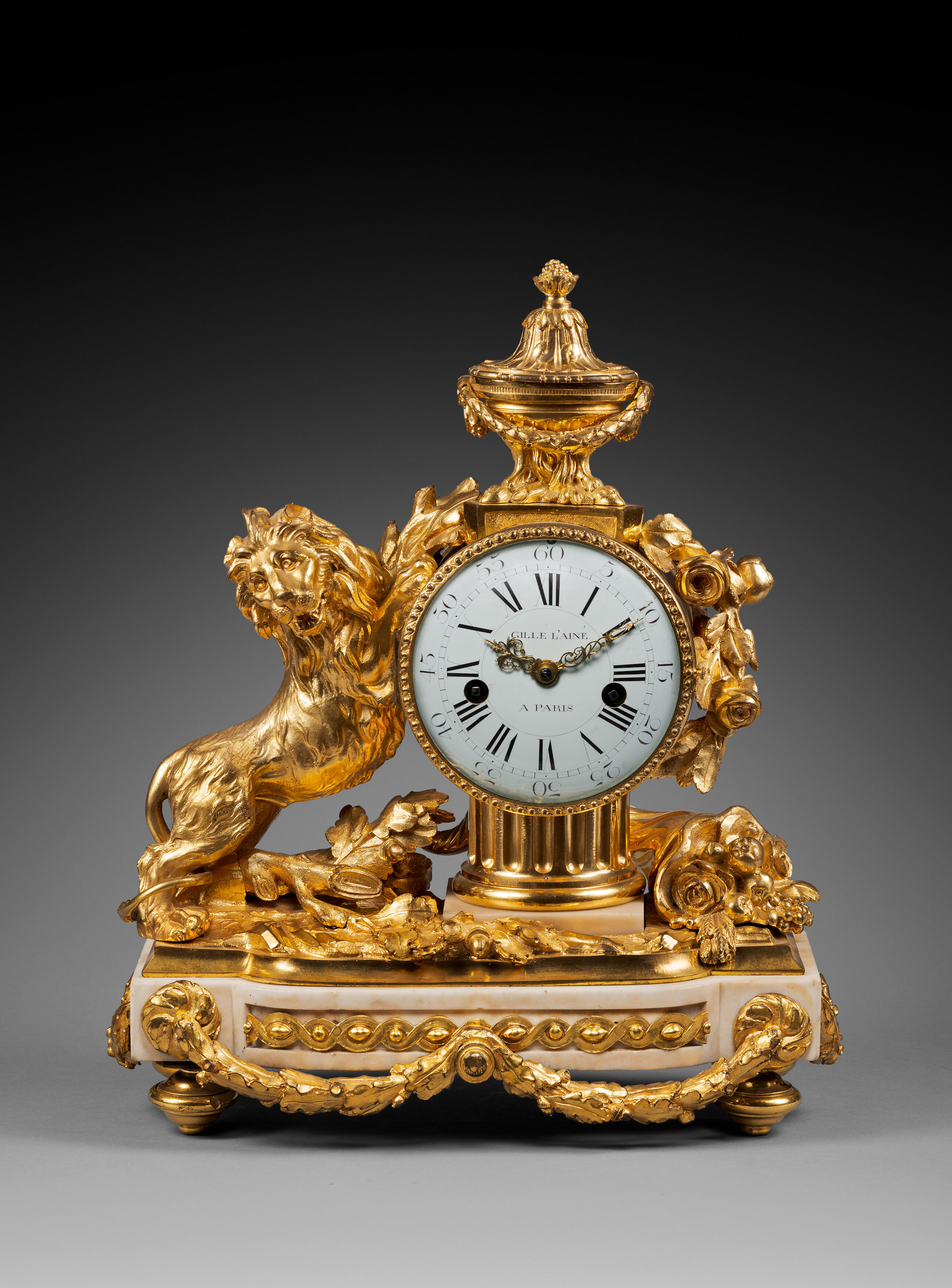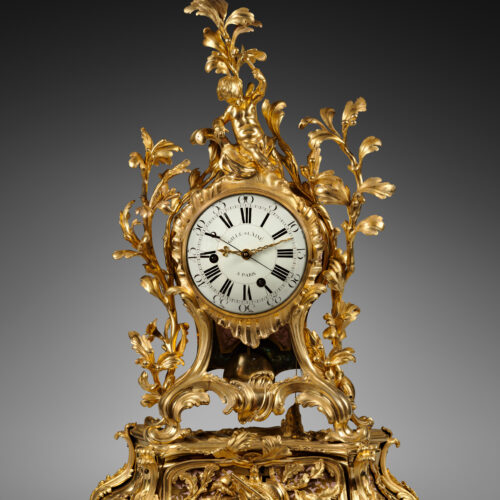Exceptional Mantel Clock made of Gilt and Patinated Bronze with Matte and Ormolu Gilding
The Rhinoceros and the Chinaman
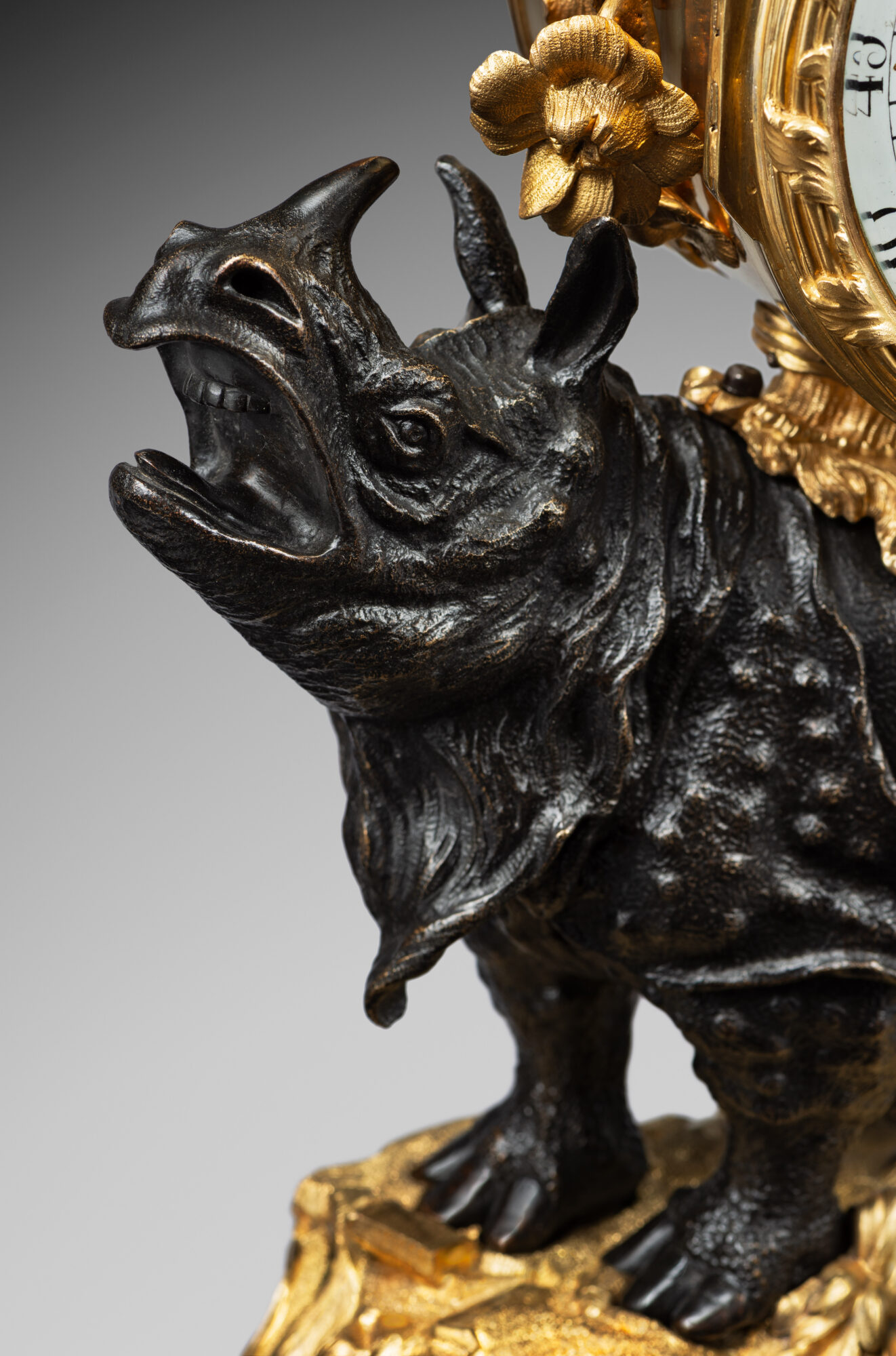
Dial and Movement signed by Master Clockmaker Jean-Baptiste III Baillon
Counter-enamel signed “a.n. Martinière” by Enameller Antoine-Nicolas Martinière
Case attributed to Master Bronze Caster Jean-Joseph de Saint-Germain
Paris, Louis XV period, circa 1750
Bibliography:
– Elegance and Wonder: Masterpieces of European Art from the Jordan and Thomas A. Saunders III Collection, Virginia Museum of Fine Arts, Richmond, Virginia, May 2022-October 2023.
– J-D. Augarde, A Journey Through Clocks, Masterworks of the Parnassia Collection, Volume I Classical Clocks, Editions Faton, Dijon, 2022, p.276-279, ref n°70
The circular enamel dial, signed “Jean-Baptiste Baillon”, indicates the Roman numeral hours, alternating with applied gold fleurs de lys and the Arabic numeral five-minute intervals by means of two pierced and chased gilt bronze hands. The counter-enamel is signed “a.n. Martinière”. The hour and half-hour striking movement is signed “JBte Baillon à Paris”. It is housed in a finely chased case made of patinated and gilt bronze with matte gilt and ormolu finishing. The drum case, whose bezel is decorated with reeds and foliage, is further adorned by lateral flowering branches. Surmounting it is a Chinese man placed on a rocky terrace. In the back, the plaque covering the mechanism is made of pierced bronze adorned with flowers, C-scrolls and foliage, and is lined with raspberry-colored material. The drum case is placed on the back of a magnificent rhinoceros that is raising its head, with its ears pricked up and its mouth wide open. The animal’s rough skin is naturalistically rendered. It stands on its four legs, on a rocaille base decorated with C-scroll motifs, foliage, and tufts of grass.
The present clock is a perfect illustration of the keen interest in exoticism and naturalism shown by important Parisian collectors. The enthusiasm for all phenomena that were foreign to European culture was, indeed, a form of curiosity that characterized the spirit of the Age of Enlightenment during the 18th century. The remarkable design of the clock was inspired by the first rhinoceros known to Europe: a female coming from Asia, named Clara and warmly nicknamed Mademoiselle Clara. It was presented to Louis XV in 1749 in the Menagerie of the Versailles Castle, and was greatly admired by Parisians, who were fascinated by this mammal that seemed to be at the crossroads of reality and superstition. As was often the case, the animal’s fame brought about many depictions of it in the decorative arts of the time, and in particular several clock models representing this exotic animal. The famous Parisian bronze caster Jean-Joseph de Saint-Germain began making models that included several variations, no doubt to satisfy requests by influential collectors or the great marchands-merciers (merchants of luxury objects) of the time. The variations might include the posture – more or less aggressive – of the rhinoceros, as well as the treatment of the figure surmounting the clock. The present example may be confidently attributed to Saint-Germain, for a small number of similar examples are known (sometimes featuring variations), which are stamped with Saint-Germain’s signature.
One type is known in which the position of the rhinoceros is inversed. One such example, whose movement is signed Dutertre, is on display in the Musée des Arts Décoratifs in Lyon (see P. Arizzoli-Clémentel, Ô Temps suspends ton vol, Catalogue des pendules et horloges du Musée des Arts décoratifs de Lyon, Lyon, 2008, p.5 9). A second type, one example of which was formerly in the Roberto Polo collection, features a dial signed Gille l’aîné; it is illustrated in J-D. Augarde, Les ouvriers du Temps, Genève, 1996, p. 156, fig. 123. A third example, whose dial is signed “Viger à Paris”, was formerly in the collection of Mr. and Mrs. René Grog-Carven; it is now in the Musée du Louvre (see D. Alcouffe, A. Dion-Tenenbaum and G. Mabille, Les bronzes d’ameublement du Louvre, Dijon, 2004, p. 79, catalogue n° 34).
Finally, a small number of models in which the rhinoceros is turned toward the viewer’s left, are comparable to the present clock. One such clock is illustrated in Tardy, La pendule française des origines à nos jours, Ier Partie: de l’Horloge gothique à la pendule Louis XV, Paris, 1974, p. 173. A second example, whose dial is signed “Martin à Paris”, is shown in H. Ottomeyer and P. Pröschel, Vergoldete Bronzen, Band II, Munich, 1986, p. 525, fig. 2. The latter model is comparable to the clock that appears in the painting by Laurent Pécheux representing Princess Marie-Louise de Bourbon-Parme, now in the Palazzo Pitti in Florence (see H. Ottomeyer and P. Pröschel, op.cit., Band I, p. 122, fig. 2.8.1).
Jean-Baptiste III Albert Baillon (? - 1772)
Was one of the most skilled and innovative clockmakers of his day. Baillon achieved almost unprecedented success to become, in the words of F.J. Britten, “the richest watchmaker in Europe”. One of the most important clockmakers of the 18th century, he was no doubt the most famous member of an important horological dynasty. His success was largely due to his ability to organise a vast and thriving private factory in Saint-Germain-en-Laye, which was unique in the history of 18th century horology.
Managed from 1748-57 by Jean Jodin (1715-61) it remained in activity until 1765 when Baillon closed it. Renowned horologist Ferdinand Berthoud was impressed by its scale and the quality of the pieces produced; in 1753 he noted: (Baillon’s) “house is the finest and richest Clock Shop. Diamonds are used not only to decorate his Watches, but even Clocks. He has made some whose cases were small gold boxes, decorated with diamond flowers imitating nature. His house in Saint-Germain is a kind of factory. It is full of Workmen continually labouring for him…for he alone makes a large proportion of the Clocks and Watches [of Paris]”. He supplied the most illustrious clientele, not least the French and Spanish royal family, the Garde-Meuble de la Couronne as well as distinguished members of Court and the cream of Parisian society.
Baillon’s father, Jean-Baptiste II (d. 1757) a Parisian maître and his grandfather, Jean-Baptiste I from Rouen were both clockmakers, as was his own son, Jean-Baptiste IV Baillon (1752 – c.1773). Baillon himself was received as a maître-horloger in 1727. In 1738 he secured his first important appointment as Valet de Chambre-Horloger Ordinaire de la Reine. Sometime before 1748 he was made Premier Valet de Chambre de la Reine and in 1770, Premier Valet de Chambre and Valet de Chambre-Horloger Ordinaire de la Dauphine Marie-Antoinette. By 1738 he was established, appropriately, in the Place Dauphine, and after 1751 in the rue Dauphine.
Baillon used only the finest cases and dials. The latter were supplied by Antoine-Nicolas Martinière and Chaillou while his cases were supplied by Jean-Baptiste Osmond, Balthazar Lieutaud, the Caffiéris, Vandernasse, Edmé Roy and especially Jean-Joseph de Saint-Germain (1719-91).
His success allowed Jean-Baptiste Baillon to amass a huge fortune, valued at the time of his death on April 8, 1772 at 384,000 livres. His collection of fine and decorative arts was auctioned on June 16, 1772, while his remaining stock, valued at 55,970 livres, was offered at sale on February 23, 1773. The sale included 126 finished watches, totalling 31,174 livres and 127 finished watch movements at 8,732 livres. His clocks, with a total value of 14,618 livres, included 86 clocks, 20 clock movements, seven marquetry clock cases, one porcelain clock case and eight bronze cases.
Today one can admire Baillon’s work in some of the world’s most prestigious collections, including the Louvre, the Musée des Arts Décoratifs, the Musée National des Techniques, the Petit Palais and the Jacquemart-André Museum in Paris; Versailles; the Musée Paul Dupuy in Toulouse; the Residenz Bamberg; the Neues Schloss in Bayreuth; the Museum für Kunsthandwerk, Frankfurt; the Residenz in Munich and the Schleissheim Castle. Further museums include the Royal Art and History Museum in Brussels; the Spanish Patrimonio Nacional; the Metropolitan Museum in New York; the Newark Museum; the Walters Art Gallery in Baltimore and Dalmeny House in South Queensferry.
Antoine-Nicolas Martinière (1706 - 1784)
Antoine-Nicolas Martinière was one of the most important Parisian enamellers of the reign of Louis XV. The son of enameller Nicolas Martinière, in September 1736 he married Geneviève Larsé, the daughter of clockmaker François Larsé, and became a master in Paris on July 3, 1720. He was described at the time as being a Marchand verrier-fayancier-émailleur-patenötrier (Merchant glassmaker- faience maker-enameller-maker of rosaries). His workshop was mentioned as being in the rue Neuve Nôtre Dame in 1736, the rue des Ursins in 1738, the rue Dauphine in 1740, and the rue des Cinq Diamants as of 1741. He quickly gained fame and became very successful, receiving the title of Emailleur et Pensionnaire du Roi in 1741 (translates to “Enameller and Resident of the King”). From 1741 to 1742 he made the famous perpetual almanac for Louis XV that is today in the Wallace Collection in London. He worked with many famous artisans, such as the bronze caster Jean-Joseph de Saint-Germain and the clockmakers Jean-Baptiste III Albert Baillon, Etienne Le Noir and Jean-Baptiste Gosselin. After several decades of professional activity, he died in Paris on August 27, 1784. At the time he lived in rue Quincampoix, Saint-Merry Parish.
Jean-Joseph de Saint-Germain (1719 - 1791)
He was probably the most renowned Parisian of the mid 18th century. Active as of 1742, he did become a master craftsman until July 1748. He became famous for his many clock and cartel cases, such as his Diana the Huntress (an example is in the Louvre Museum), the clock supported by two Chinamen (a similar example is in the Musée des Arts décoratifs in Lyon), as well as several clocks based on animal themes, including elephant and rhinoceros clocks (an example in the Louvre Museum). In the early 1760’s he played an important role in the renewal of the French decorative arts and the development of the Neo-classical style, an important example of which may be seen in his Genius of Denmark clock, made for Frederic V and based on a model by Augustin Pajou (1765, in the Amalienborg Palace, Copenhagen). Saint-Germain also made several clocks inspired by the theme of Learning, or Study, based on a model by Louis-Félix de La Rue (examples in the Louvre Museum, the Gulbenkian Foundation, Lisbon, and the Metropolitan Museum in New York). Along with his clock cases, Saint-Germain also made bronze furniture mounts, such as fire dogs, wall lights, and candelabra. His entire body of work bears witness to his remarkable skills as a chaser and bronzeworker, as well as to his extraordinary creativity. He retired in 1776.
Discover our entire collection of rare clocks on La Pendulerie Paris.
